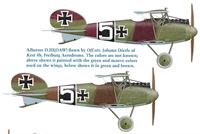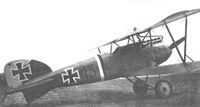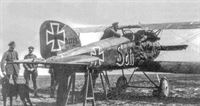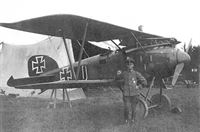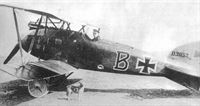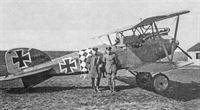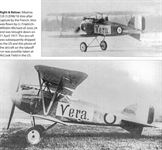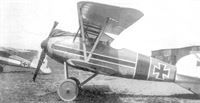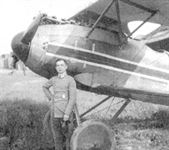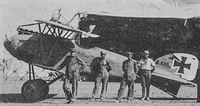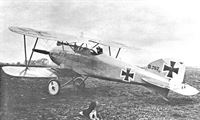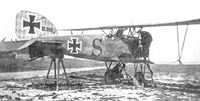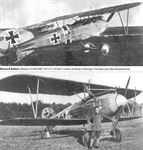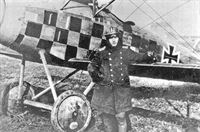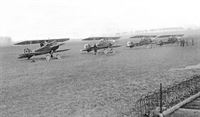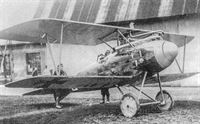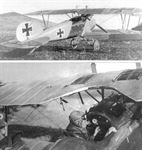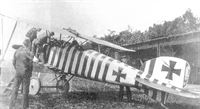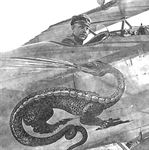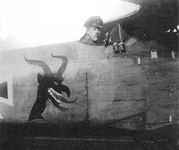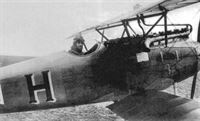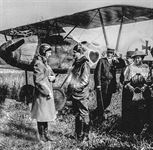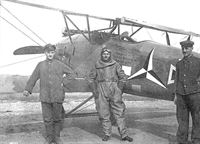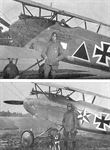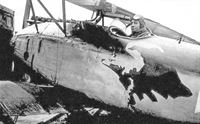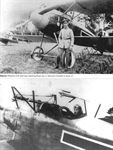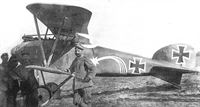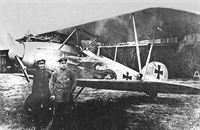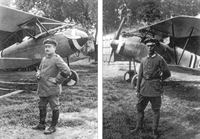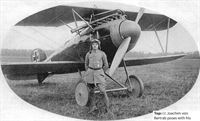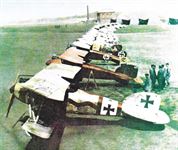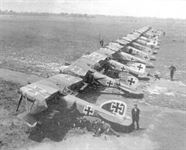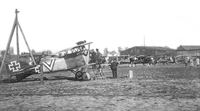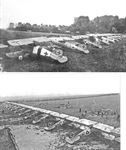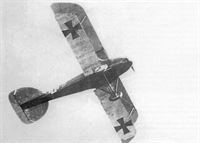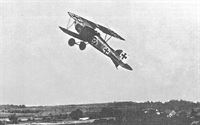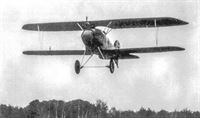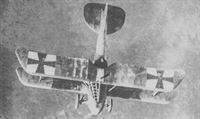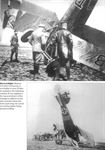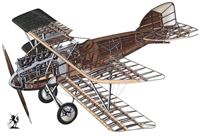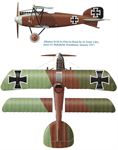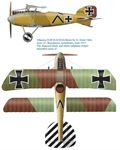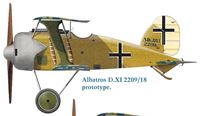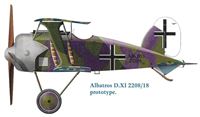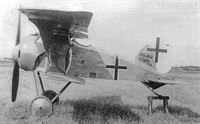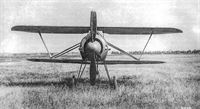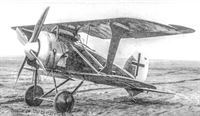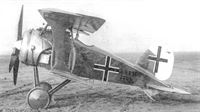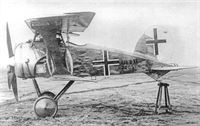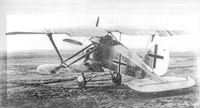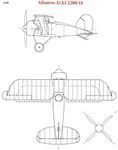Книги
Centennial Perspective
J.Herris
Albatros Aircraft of WWI. Volume 4: Fighters
447
J.Herris - Albatros Aircraft of WWI. Volume 4: Fighters /Centennial Perspective/ (27)
Oeffag-Built Albatros D.II & D.III
In late 1916 the Luftfahrtruppen (Austro-Hungarian Air Service, or LFT) was bringing into service its first fighter to be produced in quantity, the Brandenburg KD, also known as the D.I. While strong and fast, the KD had poor handling qualities, and Austrian aviation authorities wanted an alternative. Indeed, they needed one; early KD combat evaluation in late 1916 and early 1917 was not favorable.
Fortunately, the LFT had been watching what the German air service was doing, and saw the impressive combat effectiveness displayed by the new Albatros fighters over the Western Front. As a result, the LFT and Austrian industry moved very quickly to produce the Albatros under license. The first production contract was signed with the Oesterreichische Flugzeugfabrik A.G. (Oeffag) on December 4, 1916, only a few months after the Albatros entered combat. Serious discussions between the LFT and Oeffag had obviously been underway for some time, because Oeffag already had production of the first aircraft underway!
First flight of the Albatros D.II(Oef) 53.01 production prototype was in January 1917. The common fuselages of the 50 aircraft ordered, originally planned as 20 D.II(Oef) and 30 D.III(Oef) fighters, were completed in February, but completion of the wing cellules was delayed pending structural load tests. Winter weather delayed flight trials and the required radiators and propellers had to be obtained. The D.II(Oef) was finally released for service use on 4 May 1917, and the 16 aircraft built were delivered to the front. Armament was specified as two guns but some aircraft only had one; the Bernatzik synchronizer was used.
Production was shifted to the superior D.III(Oef) before the full 20 D.II(Oef) planned were built. Before starting D.III(Oef) production, Oeffag redesigned the D.III's sesquiplane wing for greater strength, with stronger spars, ribs, and fuselage connection. During the evaluation period reports of wing structural failures of German D.III fighters reached Oeffag and the static load tests on the revised wing were repeated before the D.III(Oef) was accepted for service. The Oeffag engineers, who strengthened the wing design on their own initiative, were vindicated by the exemplary service of the D.III(Oef), which was not subject to the structural failures of its German antecedent.
Like the earlier D.II(Oef), the D.III(Oef) was initially powered by the 185 hp Daimler. Two batches totaling 45 of these fighters were built (serials 53.20-53.64) before the more powerful 200 hp Daimler became available. The improved fighter was known as the 153 series and four batches of these were built. From the beginning of the third 153 series production batch the spinner was deleted in favor of a rounded nose; this improved propeller efficiency and boosted top speed by about 14 km/h.
The D.III(Oef) was fast, maneuverable, and had a good climb rate. As important, it was structurally robust and earned the trust of its pilots, who were able to engage their adversaries with a fighter that was equal or superior in performance to those they faced.
The final version of the D.III|Oef) was powered by the 225 hp Daimler and known as the 253 series; two batches of these were ordered and about 230 were delivered before the Armistice. The 253 series offered excellent performance that its pilots felt matched any Allied fighter and met all requirements. This experience was in stark contrast to their German allies, whose Albatros D.III and D.V fighters were technically inferior on the Western Front by the summer of 1917. Given Germany's mid-1917 search for a superior replacement to their Albatros fighters, it is interesting they did not look more closely at the D.III(Oef).
Oeffag-Built (Austro-Hungarian) Albatros Fighter Production Orders
Date Ordered Type Qty Serials Engine
4 December 1916 D.II(Oef) 16(1) 53.01-53.16 185 hp Daimler
4 December 1916 D.III(Oef) 34 53.20-53.53 185 hp Daimler
3 February 1917 D.III(Oef) 11 53.54-53.64 185 hp Daimler
3 February 1917 D.III(Oef) 61 153.01-153.61 200 hp Daimler
18 July 1917 D.IH(Oef) 50 153.62-153.111 200 hp Daimler
8 October 1917 D.III(Oef) 100 153.112-153.211 200 hp Daimler
18 May 1918 D.III(Oef) 70 153.212-153.281 200 hp Daimler
18 May 1918 D.III(Oef) 230(2) 253.01-253.230 225 hp Daimler
August 1918 D.III(Oef) 100 253.231-253.330 225 hp Daimler
Notes:
1. Originally 20 D.II(Oef) were ordered, but only 16 were built.
2. 201 of this production batch accepted by October 1918. A total of 260 Series 253 fighters were completed, with the last 30 or so after the Armistice.
Oeffag-Built (Austro-Hungarian) Albatros Fighter Specifications
D.II Series 53 D.III Series 53.2 D.III Series 153 D.III Series 253
Engine 185 hp Daimler 185 hp Daimler 200 hp Daimler 225 hp Daimler
Span (Upper) 8.50 m 9.00 m 9.00 m 9.00 m
Span (Lower) 8.00 m 8.73 m 8.73 m 8.73 m
Chord (Upper) 1.70 m 1.50 m 1.50 m 1.50 m
Chord (Lower) 1.70 m 1.00 m 1.00 m 1.00 m
Gap 1.35 m 1.47 m 1.47 m 1.47 m
Stagger 0.12 m 0.22 m 0.22 m 0.24 m
Wing Area 24 m2 20.56 m2 20.56 m2 20.56 m2
Length 7.35 m 7.35 m 7.35 m 7.43 m
Height 2.71 m 2.80 m 2.80 m 2.64 m
Track 1.80 m 1.80 m 1.80 m 1.80 m
Empty Weight - 690 kg 710 kg 722 kg
Loaded Weight 898 kg 964 kg 987 kg 995 kg
Wing Loading 37.4 kg/m2 46.7 kg/m2 48.0 kg/m2 48.4 kg/m2
Power Loading 4.85 kg/hp 5.21 kg/hp 4.94 kg/hp 4.42 kg/hp
Max. Speed 170 km/h 180 km/h 188 km/h 202 km/h
Climb, 1,000 m 4 min. 30 sec. 3 min. 20 sec. 2 min. 35 sec. 3 min. 5 sec.
Climb, 2,000 m 7 minutes - 6 min. 35 sec. 7 min. 10 sec.
Climb, 3,000 m 12 min. 30 sec. 14 min. 30 sec. 11 min. 20 sec. 11 min. 20 sec.
Climb, 4,000 m - - 18 min. 50 sec. 17 min. 15 sec.
Climb, 5,000 m - 32 minutes 33 minutes 27 minutes
Notes:
1. All were armed with two machine guns except a few D.II had only one gun.
2. Series 153 performance given for aircraft with spinner. From 153.112 the Oeffag-built D.III fighters had a rounded nose without spinner that increased speed by about 14 km/h.
In late 1916 the Luftfahrtruppen (Austro-Hungarian Air Service, or LFT) was bringing into service its first fighter to be produced in quantity, the Brandenburg KD, also known as the D.I. While strong and fast, the KD had poor handling qualities, and Austrian aviation authorities wanted an alternative. Indeed, they needed one; early KD combat evaluation in late 1916 and early 1917 was not favorable.
Fortunately, the LFT had been watching what the German air service was doing, and saw the impressive combat effectiveness displayed by the new Albatros fighters over the Western Front. As a result, the LFT and Austrian industry moved very quickly to produce the Albatros under license. The first production contract was signed with the Oesterreichische Flugzeugfabrik A.G. (Oeffag) on December 4, 1916, only a few months after the Albatros entered combat. Serious discussions between the LFT and Oeffag had obviously been underway for some time, because Oeffag already had production of the first aircraft underway!
First flight of the Albatros D.II(Oef) 53.01 production prototype was in January 1917. The common fuselages of the 50 aircraft ordered, originally planned as 20 D.II(Oef) and 30 D.III(Oef) fighters, were completed in February, but completion of the wing cellules was delayed pending structural load tests. Winter weather delayed flight trials and the required radiators and propellers had to be obtained. The D.II(Oef) was finally released for service use on 4 May 1917, and the 16 aircraft built were delivered to the front. Armament was specified as two guns but some aircraft only had one; the Bernatzik synchronizer was used.
Production was shifted to the superior D.III(Oef) before the full 20 D.II(Oef) planned were built. Before starting D.III(Oef) production, Oeffag redesigned the D.III's sesquiplane wing for greater strength, with stronger spars, ribs, and fuselage connection. During the evaluation period reports of wing structural failures of German D.III fighters reached Oeffag and the static load tests on the revised wing were repeated before the D.III(Oef) was accepted for service. The Oeffag engineers, who strengthened the wing design on their own initiative, were vindicated by the exemplary service of the D.III(Oef), which was not subject to the structural failures of its German antecedent.
Like the earlier D.II(Oef), the D.III(Oef) was initially powered by the 185 hp Daimler. Two batches totaling 45 of these fighters were built (serials 53.20-53.64) before the more powerful 200 hp Daimler became available. The improved fighter was known as the 153 series and four batches of these were built. From the beginning of the third 153 series production batch the spinner was deleted in favor of a rounded nose; this improved propeller efficiency and boosted top speed by about 14 km/h.
The D.III(Oef) was fast, maneuverable, and had a good climb rate. As important, it was structurally robust and earned the trust of its pilots, who were able to engage their adversaries with a fighter that was equal or superior in performance to those they faced.
The final version of the D.III|Oef) was powered by the 225 hp Daimler and known as the 253 series; two batches of these were ordered and about 230 were delivered before the Armistice. The 253 series offered excellent performance that its pilots felt matched any Allied fighter and met all requirements. This experience was in stark contrast to their German allies, whose Albatros D.III and D.V fighters were technically inferior on the Western Front by the summer of 1917. Given Germany's mid-1917 search for a superior replacement to their Albatros fighters, it is interesting they did not look more closely at the D.III(Oef).
Oeffag-Built (Austro-Hungarian) Albatros Fighter Production Orders
Date Ordered Type Qty Serials Engine
4 December 1916 D.II(Oef) 16(1) 53.01-53.16 185 hp Daimler
4 December 1916 D.III(Oef) 34 53.20-53.53 185 hp Daimler
3 February 1917 D.III(Oef) 11 53.54-53.64 185 hp Daimler
3 February 1917 D.III(Oef) 61 153.01-153.61 200 hp Daimler
18 July 1917 D.IH(Oef) 50 153.62-153.111 200 hp Daimler
8 October 1917 D.III(Oef) 100 153.112-153.211 200 hp Daimler
18 May 1918 D.III(Oef) 70 153.212-153.281 200 hp Daimler
18 May 1918 D.III(Oef) 230(2) 253.01-253.230 225 hp Daimler
August 1918 D.III(Oef) 100 253.231-253.330 225 hp Daimler
Notes:
1. Originally 20 D.II(Oef) were ordered, but only 16 were built.
2. 201 of this production batch accepted by October 1918. A total of 260 Series 253 fighters were completed, with the last 30 or so after the Armistice.
Oeffag-Built (Austro-Hungarian) Albatros Fighter Specifications
D.II Series 53 D.III Series 53.2 D.III Series 153 D.III Series 253
Engine 185 hp Daimler 185 hp Daimler 200 hp Daimler 225 hp Daimler
Span (Upper) 8.50 m 9.00 m 9.00 m 9.00 m
Span (Lower) 8.00 m 8.73 m 8.73 m 8.73 m
Chord (Upper) 1.70 m 1.50 m 1.50 m 1.50 m
Chord (Lower) 1.70 m 1.00 m 1.00 m 1.00 m
Gap 1.35 m 1.47 m 1.47 m 1.47 m
Stagger 0.12 m 0.22 m 0.22 m 0.24 m
Wing Area 24 m2 20.56 m2 20.56 m2 20.56 m2
Length 7.35 m 7.35 m 7.35 m 7.43 m
Height 2.71 m 2.80 m 2.80 m 2.64 m
Track 1.80 m 1.80 m 1.80 m 1.80 m
Empty Weight - 690 kg 710 kg 722 kg
Loaded Weight 898 kg 964 kg 987 kg 995 kg
Wing Loading 37.4 kg/m2 46.7 kg/m2 48.0 kg/m2 48.4 kg/m2
Power Loading 4.85 kg/hp 5.21 kg/hp 4.94 kg/hp 4.42 kg/hp
Max. Speed 170 km/h 180 km/h 188 km/h 202 km/h
Climb, 1,000 m 4 min. 30 sec. 3 min. 20 sec. 2 min. 35 sec. 3 min. 5 sec.
Climb, 2,000 m 7 minutes - 6 min. 35 sec. 7 min. 10 sec.
Climb, 3,000 m 12 min. 30 sec. 14 min. 30 sec. 11 min. 20 sec. 11 min. 20 sec.
Climb, 4,000 m - - 18 min. 50 sec. 17 min. 15 sec.
Climb, 5,000 m - 32 minutes 33 minutes 27 minutes
Notes:
1. All were armed with two machine guns except a few D.II had only one gun.
2. Series 153 performance given for aircraft with spinner. From 153.112 the Oeffag-built D.III fighters had a rounded nose without spinner that increased speed by about 14 km/h.
Albatros D.III(Oef) 53.46 flown by Hptm. Johann Print, commander of Flik 27. Formerly an observer with Flik 23 where he claimed 6 victories with various pilots, Print was retraining as a pilot when he was killed in the crash of this aircraft on 25 February 1918.
Albatros D.III(Oef) 153.10 flown by Hptm. Godwin Brumowski, commander of Flik 41J, February-March 1918. Brumowski scored 35 victories (and 5 balloons) and was the leading Austro-Hungarian ace; he survived the war.
Albatros D.III(Oef) 153.37 thought to be assigned to Flik 41J, May 1918. This aircraft used the Oeffag company logo as a personal marking. The spinner has been removed.
Albatros D.III(Oef) 153.45 flown by Hptm. Godwin Brumowski, commander of Flik 41J, Sesana Aerodrome, November 1917. With 35 victories Brumowski was the leading Austro-Hungarian ace.
Albatros D.III(Oef) 153.137 flown by Stbs.Fldw. Josef Novak, Flik 41J, Torresella Aerodrome, January 1918.
Albatros D.III(Oef) 153.266 flown by Lt. Sigmund von Josipovich of Flik 51J, June 1918. Von Josipovich was shot down and made POW on 15 June 1918 by Italy's leading ace, Maj. Francesco Baracca for his 34th and final victory. Four days later Baracca was KIA.
Albatros D.III(Oef) 253.116 flown by Oblt. Friedrich Navratil, commander of Flik 3J, Romagrano Aerodrome, August 1918. Navratil scored 10 victories and survived the war.
Albatros D.III(Oef) 253.XXX flown by Major Cedric Fauntleroy, commander of No. 7 Eskadra Kosciuszko, Lewandowka Aerodrome, Spring-Summer 1920, Polish Air Service.
Albatros D.III(Oef) 253.XXX of No. 7 Eskadra Kosciuszko, Lewandowka Aerodrome, Spring-Summer 1920, Polish Air Service.
This D.II(Oef) has the full winter cowling over the engine; the muzzle of the left gun is clearly visible.
D.II(Oef) 53.15 was the next to last production aircraft; here it is serving at the front. Oeffag-built Albatros D.IIs and the first production series D.IIIs were powered by the 185 hp Austro-Daimler
Albatros D.III 53.21 in Wr. Neustadt, Werksflugfeld, April 1917, aufgenommen vor dem Abnahmeflug
Albatros D.III 53.21 в Wr. Нойштадт, заводской аэродром, апрель 1917 года, снято перед приемным полетом.
The unarmed Albatros D.III(Oef) 53.21 production prototype awaiting flight test on the Oeffag factory airfield in February or March 1917. The fighter was accepted on 17 May 1917 and, along with D.III(Oef) 53.20, ordered to the 7.Armee on 29 May 1917.
Albatros D.III(Oef) 53.21 was the second production aircraft. The high quality workmanship of the Oeffag-built aircraft is evident. Due to the strengthened wing of the Oeffag D.IIIs compared to the German originals, the Oeffag-built aircraft did not suffer the lower wing failures that affected German-built aircraft. While serving with Flik 44F, 53.21 forced down a Russian Nieuport 23 in Transylvania on 29 September 1917.
Albatros D.III 53.21 в Wr. Нойштадт, заводской аэродром, апрель 1917 года, снято перед приемным полетом.
The unarmed Albatros D.III(Oef) 53.21 production prototype awaiting flight test on the Oeffag factory airfield in February or March 1917. The fighter was accepted on 17 May 1917 and, along with D.III(Oef) 53.20, ordered to the 7.Armee on 29 May 1917.
Albatros D.III(Oef) 53.21 was the second production aircraft. The high quality workmanship of the Oeffag-built aircraft is evident. Due to the strengthened wing of the Oeffag D.IIIs compared to the German originals, the Oeffag-built aircraft did not suffer the lower wing failures that affected German-built aircraft. While serving with Flik 44F, 53.21 forced down a Russian Nieuport 23 in Transylvania on 29 September 1917.
The pilot on the left is Hptm. Godwin Brumowski, the leading ace of the Austro-Hungarian Empire with 35 victories. Behind him on the left is his aircraft, Albatros D.III(Oef) 153.52, which was marked with skulls on the fuselage sides and top behind the cockpit. The pilot on the right describing air combat maneuvers is Oblt. Frank Linke-Crawford, with 27 victories the fourth-ranked ace of the Austro-Hungarian Empire. On the right is his fighter, Albatros D.III(Oef) 153.16, which was marked with falcons on the fuselage sides. This photo was taken at Flik 41J at Torresella airfield in December 1917.
Twin Schwarzlose guns mounted to fire over the propeller arc on Albatros D.III(Oef) was a front-line modification. Although one noted reference identifies this aircraft as 53.57 flown by Korporal Eugen Bonsch of Flik 51 J, information taken from the print indicates it is 53.27 flown at Flik 41J by Godwin Brumowski - at extreme left in the photo with his characteristic monocle - in July 1917. Synchronizer technical problems and shortages plagued the Luftfahrtruppen.
Albatros D.III(Oef) 153.33 was flown by Rittmeister W. von Froreich, commander of Flik 51 J, at Haidenschaft in September-October 1917.
Albatros D.III(Oef) 153.112 was the first aircraft in the third series 153 production batch and had the 200 hp Daimler. It wore a colorful camouflage scheme. In April 1918 it was flown by Oblt. Friedrich Navratil of Flik 41J. Replacement of the propeller spinner with the rounded nose in later production aircraft as seen here increased speed by 14 km/h.
Albatros D.III(Oef) 153.117 was fitted with the 200 hp Daimler. The rugged terrain of this section of the front made flying operations especially challenging for the primitive aircraft of the time.
The round-nose Albatros D.III(Oef) 153.202, which Oberleutnant August Selinger of Flik 42/J safely landed in badly shot-up condition after combat with Italian Hanriot fighters on 25 June 1918.
Albatros D.III(Oef) 153.202 flown by Oblt. August Selinger of Flik 42J after being damaged in combat with Italian Hanriot HD.1 fighters on 28 July 1918. He was killed in this aircraft on 28 August 1918.
Albatros D.III(Oef) 153.202 flown by Oblt. August Selinger of Flik 42J after being damaged in combat with Italian Hanriot HD.1 fighters on 28 July 1918. He was killed in this aircraft on 28 August 1918.
Albatros D.III(Oef) 253.75 had the 225 hp Daimler. The insignia are not finished and the pilot, ace Julius Arigi, wears a parachute. With 32 victories Arigi was the second-ranked Austro-Hungarian ace of the war.
Albatros D.III(Oef) series 253 flown by the Polish air service postwar. In addition to this 225 hp engine, the 253 series also had ailerons and elevators with wire trailing edges giving them a scalloped appearance.
Albatros D.III(Oef) flown by Godwin Brumowski, the leading Austro-Hungarian ace, with an unknown woman in the cockpit. When Brumowski's wife was asked if she was the woman in the photo, she vehemently denied it!
The full winter engine cowling of a later-production Albatros D.III(Oef) with the rounded nose. The muzzles of the two synchronized machine guns protrude from the beautifully-finished metal. During warmer weather the panel over the engine cylinder head was removed for additional cooling.
One of three Albatros D.III(Oef) series 153 fighters modified with twin synchronized Schwarzlose guns mounted in front of the pilot.
Upper surfaces of wings, tail, and fuselage overall green with ochre sworls. This was initially done at Flik 41J commanded by Brumowski and in recent years often referred to as the "Brumowski distribution pattern." It is shown here on a series 53/153.
Factory finish for all series of Oeffag-built D.III fighters was a plain varnished fuselage with clear-doped wings and gray or natural metal cowl. It is shown here on a series 253.
All upper surfaces given a dark green mottle applied by rag or sponge with underside left in plain factory finish. It is shown here on a series 253.
On some series 253 aircraft a printed fabric was used to cover the wings and tail surfaces. On some of these aircraft the fabric was also applied to the fuselage as shown here. The underside of the fuselage was left in varnished ply finish.
Albatros D.I
When it arrived on the Western Front in late August 1916 the Albatros D.I was a significant advance over existing Allied fighters. Key features that made it so formidable included the first use of the powerful and reliable 160 hp Mercedes D.III engine in a fighter, fitting two synchronized machine guns, and the strong, streamlined semi-monocoque fuselage constructed of wood frames covered by a thin plywood skin. The result was a compact, robust, streamlined fighter of very good performance and firepower that was easy to fly.
The speed, climb rate, diving speed, and firepower of the Albatros D.I were all superior to the performance of the DH.2 and Nieuport fighters that were the best and most numerous Allied adversaries and that gave the Albatros immediate technical superiority. Together with the Halberstadt and Fokker biplane fighters that had arrived slightly earlier, Albatros appeared at the front just in time to help supply the first specialized German fighter units with fighters. The first 16 Jastas, formed in September and October 1916, were primarily equipped with those types and some leftover Fokker Eindeckers. Eventually the Albatros demonstrated superior performance and combat effectiveness over these competitors and consequently was built in much greater numbers. The combination of specialized fighter units with aggressive unit tactics developed by ace Oswald Boelcke and the new Albatros fighters enabled the German air service to quickly establish air superiority. However, the Allies had so many more aircraft than Germany that they were able to perform their reconnaissance and artillery-spotting missions despite the increasing losses to the German fighters.
The Albatros D.I design did have room for improvement. It used conventional wood and fabric wing construction typical of the time, the high-mounted wing and cabane strut design obscured the pilot's field of view, especially upward to the front, and the ear-type radiator installation was problematic. The ear radiators created significant drag and when leakage occurred from solder failures or combat damage, allowed water to drain from the engine's cylinder head, quickly resulting in overheating and engine seizure when it occurred. In fact, the widespread problems with ear and side radiators in different aircraft types resulted in Idflieg banning them from all German combat aircraft on 10 November 1916. However, Idflieg’s order did not affect aircraft already built or in advanced stages of construction, and some manufacturers continued to use them for some time.
The Albatros also had a high wing-loading compared to the light, rotary-powered Allied fighters, giving a wider turning circle. The more agile Allied fighters used their maneuverability to defend themselves from attack, whereas the Albatros used its superior performance to attack when desired and to disengage when in an inferior tactical position. The slow, stable Allied reconnaissance planes found themselves at a severe disadvantage when attacked by Albatros fighters and their losses spiked.
After 50 production D.I fighters were built, production shifted to the improved D.II. Meanwhile, the D.I was adapted with floats and larger wings and tail surfaces as the Navy's W.4 floatplane fighter.
Albatros D.II
The Albatros D.II was a refinement of the D.I developed to address some of its shortcomings. In particular, the cabane structure was redesigned to improve the pilot's field of view forward and upward, the upper wing being lowered to just above the pilot's eye-level. Although early production D.II fighters retained the drag-producing ear radiators of the D.I, the ear radiators were later replaced in production by the Teves and Braun airfoil-shaped radiator that fit flush in the upper wing. In other respects the D.II was essentially identical to the D.I, and German production increased to 275 fighters, of which 75 were built under license by LVG. These were initially designated LVD D.Is but the designation was rationalized to Albatros D.II(LVG).
The D.II arrived at the front very soon after the D.I and continued its success, the increased quantity available forming the backbone of the new German Jastas. The immediate success of the Albatros fighters in combat impressed Germany's Austro-Hungarian allies and license production of the Albatros D.II and later D.III was expedited for the Austro-Hungarian air service; details are given in that section.
Albatros Fighter Production Orders
Date Ordered Type Qty Serials(1)
July 1916 D.I 50 D.421-470/16
Aug. 1916 D.II 50 D.472-521/16
1916 D.II 50 D.890-939/16
Sept. 1916 D.II 100 D.1700-1799/16
Aug. 1916 D.II(LVG) 75 D.1024-1098/16
Notes:
1. Serials D.384-391/16 assigned to prototype fighters.
3. D.I total of 50, D.II total of 275, D.III total of 1,340 (500 by Albatros & 840 by OAW).
4. D.V total 900, D.Va total 1662 (1,062 by Albatros Si 600 by OAW). Total of all Albatros fighters 4,227.
Albatros Fighter Specifications
D.I D.II D.II(LVG) D.III
Engine 160 hp Mercedes D.III 160 hp Mercedes D.III 160 hp Mercedes D.III 160 hp Mercedes D.III
Span (Upper) 8.50 m 8.50 m 8.50 m 9.00 m
Span (Lower) 8.00 m 8.00 m 8.10 m 8.81 m
Chord (Upper) 1.6 m 1.6 m 1.6 m 1.5 m
Chord (Lower) 1.6 m 1.6 m 1.6 m 1.1 m
Wing Area 24.9 m2 24.9 m2 25.2 m2 20.9 m2
Length 7.40 m 7.40 m 7.40 m 7.33 m
Height 2.95 m 2.64 m - 2.90 m
Empty Weight 694 kg 673 kg 710 kg 673 kg
Useful Load 227.5 kg 225 kg 227.5 kg 235 kg
Loaded Weight 921.5 kg 898 kg 937.5 kg 908 kg
Wing Loading 39.7 kg/m2 - 37.3 kg/m2 44.2 kg/m2
Power Loading 5.76 kg/hp 5.61 kg/hp 5.86 kg/hp 5.68 kg/hp
Max. Speed 175 km/h 175 km/h 175 km/h 175 km/h
Climb, 1,000 m 4 minutes 4 min. 50 sec. - 2 min. 30 sec.
Climb, 2,000 m 9 min. 30 sec. 9 min. 10 sec. - 6 minutes
Climb, 3,000 m 15 minutes 12 min. 40 sec. - 11 minutes
Climb, 4,000 m 23 minutes 26 minutes - 17 minutes
Climb, 5,000 m 40 minutes 37 minutes - 24 min. 30 sec.
Type-Test Accept. April-June 1916 Mid-1916 November 1916 September 1916
Note: All were armed with two machine guns
When it arrived on the Western Front in late August 1916 the Albatros D.I was a significant advance over existing Allied fighters. Key features that made it so formidable included the first use of the powerful and reliable 160 hp Mercedes D.III engine in a fighter, fitting two synchronized machine guns, and the strong, streamlined semi-monocoque fuselage constructed of wood frames covered by a thin plywood skin. The result was a compact, robust, streamlined fighter of very good performance and firepower that was easy to fly.
The speed, climb rate, diving speed, and firepower of the Albatros D.I were all superior to the performance of the DH.2 and Nieuport fighters that were the best and most numerous Allied adversaries and that gave the Albatros immediate technical superiority. Together with the Halberstadt and Fokker biplane fighters that had arrived slightly earlier, Albatros appeared at the front just in time to help supply the first specialized German fighter units with fighters. The first 16 Jastas, formed in September and October 1916, were primarily equipped with those types and some leftover Fokker Eindeckers. Eventually the Albatros demonstrated superior performance and combat effectiveness over these competitors and consequently was built in much greater numbers. The combination of specialized fighter units with aggressive unit tactics developed by ace Oswald Boelcke and the new Albatros fighters enabled the German air service to quickly establish air superiority. However, the Allies had so many more aircraft than Germany that they were able to perform their reconnaissance and artillery-spotting missions despite the increasing losses to the German fighters.
The Albatros D.I design did have room for improvement. It used conventional wood and fabric wing construction typical of the time, the high-mounted wing and cabane strut design obscured the pilot's field of view, especially upward to the front, and the ear-type radiator installation was problematic. The ear radiators created significant drag and when leakage occurred from solder failures or combat damage, allowed water to drain from the engine's cylinder head, quickly resulting in overheating and engine seizure when it occurred. In fact, the widespread problems with ear and side radiators in different aircraft types resulted in Idflieg banning them from all German combat aircraft on 10 November 1916. However, Idflieg’s order did not affect aircraft already built or in advanced stages of construction, and some manufacturers continued to use them for some time.
The Albatros also had a high wing-loading compared to the light, rotary-powered Allied fighters, giving a wider turning circle. The more agile Allied fighters used their maneuverability to defend themselves from attack, whereas the Albatros used its superior performance to attack when desired and to disengage when in an inferior tactical position. The slow, stable Allied reconnaissance planes found themselves at a severe disadvantage when attacked by Albatros fighters and their losses spiked.
After 50 production D.I fighters were built, production shifted to the improved D.II. Meanwhile, the D.I was adapted with floats and larger wings and tail surfaces as the Navy's W.4 floatplane fighter.
Albatros D.II
The Albatros D.II was a refinement of the D.I developed to address some of its shortcomings. In particular, the cabane structure was redesigned to improve the pilot's field of view forward and upward, the upper wing being lowered to just above the pilot's eye-level. Although early production D.II fighters retained the drag-producing ear radiators of the D.I, the ear radiators were later replaced in production by the Teves and Braun airfoil-shaped radiator that fit flush in the upper wing. In other respects the D.II was essentially identical to the D.I, and German production increased to 275 fighters, of which 75 were built under license by LVG. These were initially designated LVD D.Is but the designation was rationalized to Albatros D.II(LVG).
The D.II arrived at the front very soon after the D.I and continued its success, the increased quantity available forming the backbone of the new German Jastas. The immediate success of the Albatros fighters in combat impressed Germany's Austro-Hungarian allies and license production of the Albatros D.II and later D.III was expedited for the Austro-Hungarian air service; details are given in that section.
Albatros Fighter Production Orders
Date Ordered Type Qty Serials(1)
July 1916 D.I 50 D.421-470/16
Aug. 1916 D.II 50 D.472-521/16
1916 D.II 50 D.890-939/16
Sept. 1916 D.II 100 D.1700-1799/16
Aug. 1916 D.II(LVG) 75 D.1024-1098/16
Notes:
1. Serials D.384-391/16 assigned to prototype fighters.
3. D.I total of 50, D.II total of 275, D.III total of 1,340 (500 by Albatros & 840 by OAW).
4. D.V total 900, D.Va total 1662 (1,062 by Albatros Si 600 by OAW). Total of all Albatros fighters 4,227.
Albatros Fighter Specifications
D.I D.II D.II(LVG) D.III
Engine 160 hp Mercedes D.III 160 hp Mercedes D.III 160 hp Mercedes D.III 160 hp Mercedes D.III
Span (Upper) 8.50 m 8.50 m 8.50 m 9.00 m
Span (Lower) 8.00 m 8.00 m 8.10 m 8.81 m
Chord (Upper) 1.6 m 1.6 m 1.6 m 1.5 m
Chord (Lower) 1.6 m 1.6 m 1.6 m 1.1 m
Wing Area 24.9 m2 24.9 m2 25.2 m2 20.9 m2
Length 7.40 m 7.40 m 7.40 m 7.33 m
Height 2.95 m 2.64 m - 2.90 m
Empty Weight 694 kg 673 kg 710 kg 673 kg
Useful Load 227.5 kg 225 kg 227.5 kg 235 kg
Loaded Weight 921.5 kg 898 kg 937.5 kg 908 kg
Wing Loading 39.7 kg/m2 - 37.3 kg/m2 44.2 kg/m2
Power Loading 5.76 kg/hp 5.61 kg/hp 5.86 kg/hp 5.68 kg/hp
Max. Speed 175 km/h 175 km/h 175 km/h 175 km/h
Climb, 1,000 m 4 minutes 4 min. 50 sec. - 2 min. 30 sec.
Climb, 2,000 m 9 min. 30 sec. 9 min. 10 sec. - 6 minutes
Climb, 3,000 m 15 minutes 12 min. 40 sec. - 11 minutes
Climb, 4,000 m 23 minutes 26 minutes - 17 minutes
Climb, 5,000 m 40 minutes 37 minutes - 24 min. 30 sec.
Type-Test Accept. April-June 1916 Mid-1916 November 1916 September 1916
Note: All were armed with two machine guns
Albatros D.I flown by Prinz Friedrich Karl von Preussen, crown prince of Prussia. Although commanding Fl.Abt.(A) 258, the Prinz flew this D.I on patrols with Jasta Boelcke between his two-seater missions. On 21 March 1917 the Prinz was brought down in no man's land and was mortally wounded trying to escape back to German lines. The skull and crossbones insignia used on the fuselage was also applied to the spinner.
Albatros D.II D.910/16 flown by Lt. Max Bohme of Jasta 5, Gonnelieu Aerodrome, March 1917. Bohme was shot down and made POW on 4 March by Lt. Pearson, 29 Sqdn., and Lts. Graham & Boddy, 11 Sqdn. His aircraft was given British captured ID G.14.
Albatros D.II D.910/16 after being repainted by the French during evaluation at Villacoubly after being turned over to France by the British.
Albatros D.II(LVG) D.1071/16 Kobes flown by Lt. Josef Jacobs of Jasta 22, Vauz Aerodrome, March 1917. Jacobs went on to command Jasta 7, score 48 victories, and be awarded the Pour le Merite.
Albatros D.II D.1724/16 of Lt. Carl Emil Schaefer, Kasta 11, Morchingen Aerodrome, January-February 1917. Commanding Jasta 28, Schaefer scored 30 victories and was awarded the Pour le Merite before being KIA on 5 June 1917 in combat with FE.2ds of 20 Sqdn.
Albatros D.II D.1729/16 flown by Lt. Scheller of Jasta 19. Scheller scored four victories and survived the war.
Albatros D.II flown by Off.stv. Rudolf Weckbrodt of Jasta 26, early 1917. Weckbrodt scored two victories before being KIA on 14 October 1917 while attacking an RE8 in Albatros D.V 636/17.
Albatros D.II flown by Lt. Wenig of Jasta 16b, Winter 1916/1917. Wenig scored 4 victories and commanded Jasta 80b from 25 January 1918 to the Armistice.
Albatros D.II flown by Oblt. Stefan Kirmaier. Kirmaier assumed command of Jasta 2 after Boelcke's death. After scoring 11 victories he was KIA on 22 November 1916 by DH.2s of 24 Sqdn.
Albatros D.II flown by Lt. Manfred Freiherr von Richthofen of Jasta 2, Autumn 1916. Later known as the Red Baron, Manfred von Richthofen was the leading ace of the Great War.
A prototype Albatros D.I D.384/16 fighter at Johannisthal in September 1916, displays its clean, streamlined airframe at the factory, September 1916. It was the first fighter to use the 160 hp Mercedes D.III engine, giving it good performance while carrying two synchronized machine guns. The exhaust was routed above the wing.
The Albatros D.I was the first fighter powered by the 160 hp Mercedes D III engine. With their power, performance, and twin synchronized machine guns, the Albatros fighter family immediately gained superiority over existing Allied fighters. The Mercedes D.III/D.IIIa was a very reliable engine which became the most popular engine used in German fighters until the end of the war. Introduction of the over-compressed BMW IIIa finally provided better performance than the Mercedes and spurred Daimler to develop improved derivatives of their D IIIa engine.
The Albatros D.I was the first fighter powered by the 160 hp Mercedes D III engine. With their power, performance, and twin synchronized machine guns, the Albatros fighter family immediately gained superiority over existing Allied fighters. The Mercedes D.III/D.IIIa was a very reliable engine which became the most popular engine used in German fighters until the end of the war. Introduction of the over-compressed BMW IIIa finally provided better performance than the Mercedes and spurred Daimler to develop improved derivatives of their D IIIa engine.
This side view of unarmed Albatros D.I D.384/16 gives another view of its clean lines, broken only by the 'ear' radiators on both sides of the fuselage. The upper wing was mounted high above the fuselage, giving the pilot a good field of view directly forward but obscuring his vision upward. The exhaust is not the production standard and the upper wing cutout is small. The elevator does not yet have aerodynamic balances used on production fighters.
Albatros D.I 390/16 of Lt. Otto Walter Hohne of Jasta 2 takes off with other D.I fighters behind him ready to go. Hohne was wounded in action on 10 January 1917. After recovering from his wound he commanded Jasta 59 and then returned to command Jasta 2 on 26 January 1918. He was not able to lead Jasta 2 to its former success and was replaced by Karl Bolle on 20 February. He scored six victories and survived the war.
The Jasta 2 Albatros D.I flown by Lt. Karl Buttner after capture and with British markings applied over the German national insignia. It was assigned British capture number G.1. For performance evaluation a pitot airspeed indicator was added to the upper starboard wing. Interestingly, Buttner's individual markings were initially left intact.
Additional photos of Albatros D.I 391/16 flown by Lt. Karl Buttner after capture and with British markings applied over the German national insignia. The ear radiators fitted to all D.I fighters and early-production D.II fighters are clearly visible.The aircraft was repainted as shown and its serial was added as shown on the facing page, apparently after formal evaluation started; at this time Buttner's personal markings were over-painted. The D.I was a clean, robust aircraft that was the initial production type of a very famous fighter family.
Albatros D.I 391/16 flown by Lt. Karl Buttner after capture and now serving in British markings at the First School of Air Combat at Ayr.
Two views of Albatros D.I 391/16 crashed while serving in British markings at the First School of Air Combat at Ayr. This crash ended the colorful career of D.I 391/16.
Armed with the standard two guns, Albatros D.I D.435/16 at the front wears a dark camouflage finish. The national insignia are applied over white backgrounds to improve contrast. This aircraft was assigned to Lt. Spitzhoff of Jasta 5.
Albatros D.I 446/16 ready for its next mission. It wears tactical number "7" and a dark painted rudder.
Albatros D.I fighters of Jasta 2 ready to take off on 28 October, 1916. This was the mission during which Oswald Boelcke was killed in a mid-air collision with Lt. Erwin Bohme during combat with DH.2s of No.24 Squadron.
Albatros D.I flown by Lt. Dieter Collin of Jasta 2.This is the aircraft later flown by Prinz Friedrich Karl von Preussen after decoration with the death's head insignia of his Hussar regiment. The water header tank and placement of gauges/mirrors on the cabane are in the same positions when later flown by the Prinz. Lt. Collin rose to command Jasta 56 and scored 13 victories before being KIA on 25 July 1918.
Five brand new Albatros D.I fighters of Jasta 2 at Bertincourt shortly after their arrival, mid-September 1916. The right-most aircraft with the unique water header tank in front of the first cylinder, was flown by Lt. Dieter Colin, and later by Prinz Friedrich Karl von Preussen who would be shot down while flying it.
Albatros D.I fighters of Jasta 2 at Bertincourt with the unit tent hangars in the background, mid-September 1916.
Top: Albatros D.III 2051/16 in the middle and Rumpler C.I C.4633/15 at left. In the right background is the Albatros D.I fighter with skull and cross-bones insignia often flown by Prinz Friedrich Karl von Preussen, crown prince of Prussia.
Bottom: Manfred von Richthofen walks toward the photographer with a Albatros D.III 2051/16 behind him and Rumpler C.I C.4633/15 at left. In the right background is the Albatros D.I fighter with skull and cross-bones insignia often flown by Prinz Friedrich Karl von Preussen, crown prince of Prussia.
Bottom: Manfred von Richthofen walks toward the photographer with a Albatros D.III 2051/16 behind him and Rumpler C.I C.4633/15 at left. In the right background is the Albatros D.I fighter with skull and cross-bones insignia often flown by Prinz Friedrich Karl von Preussen, crown prince of Prussia.
Described as the "strange green Albatros" of Prinz Friedrich Karl von Preussen by Hptm. Adolf Ritter von Tutschek, the details of the aircraft and its markings are well shown in this view. It confirms the skull motif was also painted on the white spinner.
A closeup of the middle photo reveals a more detailed view of Prinz Karl's Albatros D.I and its markings. The aircraft was painted light green with the black and white Death's Head insignia on both sides of the fuselage and the spinner.
Prinz Friedrich Karl von Preussen, 2nd from left in the group of officers, with his Albatros D.I in the background.
Prinz Friedrich Karl von Preussen, crown prince of Prussia, in his Albatros D.I starting his take-off.
The Albatros D.I of Prinz Friedrich Karl von Preussen, crown prince of Prussia, after capture. On 21 March 1917 the prince was brought down in no man's land and was mortally wounded trying to escape back to German lines.
Lt. Wolfgang Gunther of Jasta 2 models his flight gear in the "fearless aviator" pose for the photographer with his brand new Albatros D.I as a backdrop. A brand new aircraft was a good reason for a photo.
Albatros D.I fighter of Jasta 6 flown by Vzfw. Carl Holler forms a backdrop for a Jasta portrait in early 1917.
An unarmed prototype Albatros D.II at Johannisthal airfield. The D.II had a different cabane structure than the D.I, enabling the upper wing to be lowered near the pilots' eye level, giving the pilot a better field of view forward above the horizontal. After armament was fitted and serial applied, this airplane was delivered to Oblt. Oswald Boelcke at Jasta 2 as D.386/16; this was the airplane he was flying when he experienced his fatal mid-air collision with a squadron mate. The Albatros D.I seen directly behind the D.II is the one that would be flown by Lt. Dieter Collin and Prinz Friedrich Karl von Preussen as confirmed by the water header tank in front of the first cylinder and unique to this aircraft..
Pilots liked the D.I but said the upper wing was too high above their sight-line and blocked too much of the view from the cockpit, so the wing was lowered to just above the pilots' sight-line in the D.II, requiring a different cabane design. Otherwise the two types were identical. Late production D.IIs replaced the ear radiators with lower-drag airfoil radiators in the upper wing center section.
Pilots liked the D.I but said the upper wing was too high above their sight-line and blocked too much of the view from the cockpit, so the wing was lowered to just above the pilots' sight-line in the D.II, requiring a different cabane design. Otherwise the two types were identical. Late production D.IIs replaced the ear radiators with lower-drag airfoil radiators in the upper wing center section.
Albatros D.II 460/16 with dark-painted rudder rests in front of an airship hangar, perhaps that at Metz. Compared to the D.I the upper wing of the D.II is much lower and inline with the pilot's eyes, which improved his field of view.
Albatros D.II D.473/16, the second production aircraft, under new management. This aircraft was presented intact to the British when the pilot ran out of fuel behind the lines near Abbeville on 3 May 1917. Assigned captured aircraft number G.32, it was sent to England for flight evaluation.
Albatros D.II D.484/16 was from the first production batch of D.II fighters. The engine cowling panels have been removed for maintenance.
Albatros D.II D.497/16 retained the ear radiators of the earlier D.I fighter. The rudder was painted in a dark color and the upper surfaces were camouflaged. The national insignia were applied over white squares.
Albatros D.II(OAW) D.501/16 of Jasta Boelcke undergoing scrutiny from a group of men. This aircraft had been flown at times by then Lt. Manfred von Richthofen and Adolf Ritter von Tutschek who both flew with the unit in late 1916/early 1917 before being promoted to command units of their own, namely Jastas 11 and 12 respectively. Ironically, von Tutschek would replace Richthofen's mentor and friend, Paul Henning von Osteroth, who had been one of von Richthofen's pilots during his time as an observer.
Albatros D.II(OAW) 910/16 flown by Lt. Max Bohme of Jasta 5, after being downed 4 March 1917 by Lt. AJ. Pearson of No.29 Squadron, RFC and Lts. Graham and Boddy of 11 Squadron, RFC. It was assigned British capture number G.14.
Albatros D.II(OAW) 910/16 during evaluation at Villacoubly, France. It has been repainted in a light finish, perhaps silver, with French markings, and an auxiliary strut has been added to support the tailplane. A French propeller was fitted This aircraft had the later production airfoil radiator that eliminated the drag-producing ear radiators originally used.
Albatros D.II(LVG) 1076/16 of ZAK 3 (Zentral Abnahme Kommission, Abteilung ZAK 3) after being rebuilt in 1918. The painter has incorrectly repainted the serial as D.1076/17. The ZAK was responsible for managing the repair and recycling of damaged aircraft and accepting all aircraft from manufacturers; this D.II was used by the ZAK as a communications aircraft.
Albatros D.II 1713/16 of Kest 4b (which later became Jasta 84 in 1918) retains the early ear radiators despite being an aircraft of the third (and last) Albatros production batch. Off-stv. Leim, who commanded the unit, is in the cockpit and the ground crew also pose for their portrait.
Rudolf Berthold of Jasta 14 in Albatros D.II 1717/i6 with its engine running ready to take off. A rack of flare cartridges is located on the side of the cockpit and an over-sized windscreen has been fitted.
Rudolf Berthold in Albatros D.II 1717/16 at Jasta 14's airfield. Berthold went on to score 44 victories; he was awarded the Pour le Merite and survived the war only to be murdered by radicals soon after the Armistice.
Lt. Emil Schaefer in his Albatros D.II 1724/16 of Kasta 11; he scored 30 victories and was awarded the Pour le Merite.
Albatros fighters of Kasta 11 with Schaefer's D.II 1724/16 at left. Schaefer was KIA on 5 June 1917 in a D.III.
Albatros fighters of an unidentified Jasta; the fighter on the left is D.II D.1743/16. Another D.II is second in line and the third fighter in line is a D.I; the rest of the fighters appear to be D.IIs.
Albatros D.IIs and D.IIIs of Jasta 17 appear in this lineup photo taken in the March-April 1917 timeframe. With the rapid pace of aerial combat and claims coming in it became important for units, not just pilots, to develop markings for identification both in the air and on from the ground. The system of triple stripe markings became the identifier of Jasta 17.
The Albatros D II, the fighter that turned the tide of the air war in Germany's favour, at least for a while. Albatros had first flown their prototype D I fighter during August 1916 in answer to a pressing need to counter the current ascendency of the Nieuports and DH 2s. Flight testing of the D I showed it to be fast, agile and with an excellent climb rate. The type was rushed into production so fast, that the first service deliveries were being made to Jasta 2 by early September 1916! Powered by a 160hp Mercedes D III, the less than 100 D Is built proved capable of reversing the Allies former fighter superiority. Acknowledging constructive criticism from the front line pilots, Albatros set about improving forward visibility by slightly lowering the upper mainplane to produce the D II in December 1916. With the exception of the lowered upper wing, the two machines were virtually identical. Again, D IIs were rushed to the front as soon as they were completed and tested, with LVG Roland and Ufag helping to spread the production load. Well over 300 of these 109mph top level speed at sea level, twin 7.92mm Spandau-armed single seaters were to be built before production switched to the even better Albatros D III in early 1917.
Albatros D.II fighter of Jasta 19 wearing black and white fuselage stripes being manhandled into its hangar to repair a damaged landing gear.
This unidentified early-production Albatros D.II appears to be in good condition despite being captured.
Albatros D.II at left and D.III in the center showing their common fuselage design and different radiators and wing cellules - the D.II at left retains the older ear radiators.
Albatros D.II aircraft of a Jasta, perhaps Jasta 2, in the snow. These conditions were very rigorous for wooden airplanes covered in fabric, to say nothing of the pilots flying un heated aircraft with open cockpits.
This photo was taken during the Bufa filming of Jasta 9 activities on 25 February 1917. The Caudron G4 is shown in the background of the film and also taking off, but appears not to have made the final cut. Marwitzand Kohler's Albatros D.II with the crossed swords motif on the fuselage flanks is seen here with one of those pilots. (NARA Photo Collection)
These are stills from the Bufa (Bild und Film Amt-Picture and Film Board) film taken during a visit to the airfield of Jasta 9 at Leffincourt to film newsreel footage for a film titled Ein Kampftag an der Champagne (A Combat Day on the Champagne) taken on 25 February 1917; it is now available online at www.filmportal.de. Sequence: An automobile carrying pilots of Jasta 9 trundles on to the airfield along the flight line and pulls up to the camera. The pilots clamber out of the Benz touring car and walk to where the Staffelfuhrer, Oblt. Kurt Student, is waiting to give them their pre-flight briefing.
A Benz staff car rolls onto the flight line. The car is bringing pilots from their living quarters to their waiting aircraft. The mechanics have been busy priming cylinders and carburettors, checking coolant levels, and warming the engines.The car pulls up and the pilot's clamber out.
A Benz staff car rolls onto the flight line. The car is bringing pilots from their living quarters to their waiting aircraft. The mechanics have been busy priming cylinders and carburettors, checking coolant levels, and warming the engines.The car pulls up and the pilot's clamber out.
The pilots walk to Staffelfuhrer Oblt. Kurt Student who waits to brief them prior to the mission. The man in the center of the group, Lt. Werner Junge, failed to return from this mission; having been severely wounded and dieing of his wounds the next day.The Albatros D.II with the crossed swords emblem is believed to have been the aircraft flown by Vzfw. Karl Kohler and Lt. Werner Marwitz. The crossed swords insignia shows that choice of personal markings was expanding away from the basic letters and numerals originally used.
The pilot briefing ends and the pilots man their machines, get strapped in, and prepare for takeoff. All aircraft are fitted with mud guards to keep mud and debris from being flung into, and breaking, the propellers.
The pilot of the first Albatros in the line with the checkered marking shoves the throttle forward and begins to take off; with the assist of the propeller blast the pilot immediately raises the tail off the ground.
Either Marwitz or Kohler take off next and the film crew captures it from a different angle. Again, the camera catches how responsive the tailplane was in lifting the tail off of the ground.
Jasta 9 star turn Lt. Hartmut Baldamus peers over the wing of his aircraft as the engine slowly idles. He is looking for the ground crewmen to pull the chocks so that he can take off.
After Baldamus having motioned to them, the ground crewmen grab the ropes attached to the chocks and pull them from in front of the wheels while Baldamus watches, leaning out of the cockpit to make sure the chocks and crewmen are out of the way.
Baldamus throttles up and the aircraft pulls forward while the groundcrew act as wing walkers to help maneuver the aircraft into takeoff position.
Lt. Hartmut Baldamus was a rapid scorer who, by the beginning of April 1917 had achieved 15 confirmed victories and was nearing Pour le Merite territory. He was killed in action on 14 April 1917 due to a mid-air collision with a Nieuport, which also crashed for Baldamus's 18th victory.
After Baldamus having motioned to them, the ground crewmen grab the ropes attached to the chocks and pull them from in front of the wheels while Baldamus watches, leaning out of the cockpit to make sure the chocks and crewmen are out of the way.
Baldamus throttles up and the aircraft pulls forward while the groundcrew act as wing walkers to help maneuver the aircraft into takeoff position.
Lt. Hartmut Baldamus was a rapid scorer who, by the beginning of April 1917 had achieved 15 confirmed victories and was nearing Pour le Merite territory. He was killed in action on 14 April 1917 due to a mid-air collision with a Nieuport, which also crashed for Baldamus's 18th victory.
From a different camera angle Baldamus' Albatros lunges forward gathering speed. Almost immediately the tail raises off the ground.
After landing Hartmut Baldamus exits the cockpit of his Albatros D.II and jumps to the ground.
A relieved Lt. Baldamus walks away from his Albatros D.II after another successful flight and landing.
A relieved Lt. Baldamus walks away from his Albatros D.II after another successful flight and landing.
This photo was taken by the Bufa during their visit to Leffincourt and some of the pilots in the film are shown here in posed portraits taken by Bufa photographers for distribution to card manufacturers or newspapers.
Lt. Hartmut Baldamus gives the photographer a steely glare from the cockpit in this view.
Lt. Hartmut Baldamus gives the photographer a steely glare from the cockpit in this view.
Albatros D.II(OAW) fighter flown by Lt. Knappe of Jasta 14 wears white chevrons with dark borders on top, bottom, and both sides. Interestingly, this OAW-built aircraft had LVG-style wing camouflage; were the wings replaced?
Vzfw. Wilhelm Anton Seitz of Jasta 8 poses for a photo with his Albatros D.II. Seitz was later promoted to Leutnant and given command of Jasta 68. He scored 16 confirmed victories and survived the war.
This early Albatros D.II retains the bulky ear radiators installed in the D.I. Later D.II aircraft had airfoil radiators.
Oblt. Stefan Kirmaier, Commanding Officer of Jasta 2 after Boelcke's death, and an Albatros D.II of Jasta 2.
Oblt. Oswald Boelcke, Commanding Officer of Jasta 2, in front of what was presumably his Albatros D.II of Jasta 2, October 1916.
Manfred von Richthofen in front of what was presumably his Albatros D.II of Jasta 2, Lagnicourt airfield, November 1916. Left to right: Oblt. Stefan Kirmaier (CO), Lt. Hans Immelmann, Richthofen, and Lt. Hans Wortmann.
Vzfw. Hugo Stober of Jasta 16b shows his Albatros D.II some love. Stober shot down three aircraft before being wounded in action.
This photo was taken by the Bufa during their visit to Leffincourt and some of the pilots in the film are shown here in posed portraits taken by Bufa photographers for distribution to card manufacturers or newspapers.
Lt. Hermann Pfeifer poses for a photo in his Albatros D.II. Pfeifer was serving with Jasta 9 at the time of this photo and scored 11 victories. He was killed testing a captured Nieuport 17 on 20 May 1917. Jasta 9 had an affinity for captured Nieuports; at least three are known to have been flown at the unit.
Lt. Hermann Pfeifer poses for a photo in his Albatros D.II. Pfeifer was serving with Jasta 9 at the time of this photo and scored 11 victories. He was killed testing a captured Nieuport 17 on 20 May 1917. Jasta 9 had an affinity for captured Nieuports; at least three are known to have been flown at the unit.
Hptm. Oswald Boelcke suits up for a flight in his new Albatros D.II in the Autumn of 1916. With the D.II, Boelcke got exactly what he was hoping for, a fast, stable, twin-gun platform to use as an effective tool to implement his new Jagdstaffel strategy.
Sometime in January 1917, Lt. Kralewski stood his Albatros D.II fighter on its nose at Jasta 4's Xivry-Circourt airfield. Here Kralewski stands with his Albatros in the background. An airfoil radiator located centrally in the upper wing replaced the earlier ear radiators.
Kralewski stands at center with his Albatros D.II in the background. Left to right: Werkmeister (Chief Technician) Albrecht, a naval officer, Lt. Otto Neumuller, Kralewski, ace Wilhelm Frankl, Jasta 4's paymaster. In the right background is a man about to tug on a rope attached to the plane's tail to lower it to the ground.
Typical Albatros D.II three color pattern with cross fields and airfoil radiator based on D.II 386/16.
The characteristic 'banded' pattern as applied to LVG-built Albatros D.II fighters, shown here are both two-color and three-color versions.
Albatros D.III
The Albatros fighter series reached its peak with the D.III. The D.III combined a sesquiplane wing cellule inspired by the Nieuport with the engine, fuselage, and tail of the earlier D.I and D.II. The Teves and Braun airfoil-shaped radiator position initially followed that of the late production D.II, in the center section of the upper wing. Later the radiator was moved to starboard to improve the pilot's view forward by moving the coolant line.
Based on tests and analysis of captured Nieuports, Albatros designers created a new wing cellule for the D.III. The wing span was increased and the chord decreased, especially in the much narrower lower wing. The increased span and reduced chord gave a higher aspect ratio to the wings, which reduced induced drag (drag induced by creation of lift). The very narrow chord lower wing also improved the pilot's field of view downward. The greater aerodynamic efficiency improved speed somewhat and significantly increased the climb rate. As an added bonus, the D.III looked more impressive than the D.I and D.II with their squared-off wings.
The Albatros D.II was the best fighter at the front when the superior Albatros D.III started arriving in late 1916, and by March 1917 the D.III was the most numerous German fighter at the front. By the end of April 1917 there were three times as many D.III fighters at the front as D.IIs. The D.III made a significant impact on the air war and by April its affect was traumatic. Allied losses in April 1917 were so high the month became known as "Bloody April" in the RFC. Some RFC units suffered more than 100% casualties that month; one ground machine gunner arriving at an RFC squadron wondered why everyone was so dispirited; the next day he was shot down during his first day of combat.
The impressive results achieved by the Jagdflieger in April 1917, when the Albatros D.III was the main German fighter at the front, sowed despair in the RFC and complacency at Idflieg. Such an ascendancy, based on superior technology and excellent training and tactics, could not last against enemies with the world-wide resources available to the Allies, and it did not. During the month of the RFC's blood-letting over the front, the first new-generation British fighters appeared, the SE.5 and Bristol F.2a, powered by advanced V8 (SE.5) and V12 (F.2a) engines. Both engines were quickly developed to deliver more power, resulting in the SE.5a and Bristol F.2b with even better performance. In fact, the performance of these two fighters was so good they were in first-line service at the Armistice.
The robust Sopwith Camel arrived in June 1917; its performance was similar to the Albatros but it was more maneuverable in a dog-fight and more robust, and like the Albatros it carried two synchronized guns. Ironically, the Albatros's finest moment came just as better Allied fighters were arriving.
Idflieg was caught flat-footed; it did not fully grasp the dynamic nature of the factory battle for technical superiority nor appreciate the rapid growth potential of the V8 and V12 engines. Basking in the comfort of Albatros technical superiority, there was nothing better available when the Allies leaped ahead.
Another warning sign was that, for the first time, the Albatros was starting to suffer structural problems. This was due to the Nieuport-type sesquiplane wing cellule and the weakness of the narrow, single-spar lower wing. Unknown to the Germans, the Nieuport fighters had also suffered from lower-wing failures before the Albatros D.III with its similar wing design arrived at the front. The greater weight of the Albatros compared to the light, rotary-engine Nieuports contributed to the problem,
and the Albatros's greater diving speed further aggravated the issue. Worse was to come with the arrival of the new D.V, where the problem will be discussed in more detail.
Albatros Fighter Production Orders
Date Ordered Type Qty Serials
Oct. 1916 D.III 400 D.1910-2309/16(2)
Feb.1917 D.III 50 D.600-649/17
March 1917 D.III 50 D.750-799/17
Apr. 1917 D.III(OAW) 200 D.1650-1849/17
May 1917 D.III(OAW) 200 D.2362-2561/17
June 1917 D.III(OAW) 100 D.2562-2651/17
July 1917 D.III(OAW) 200 D.3056-3255/17
Aug. 1917 D.III(OAW) 140 D.5022-5161/17
Notes:
2. Off-set radiator from D.2200/17.
3. D.I total of 50, D.II total of 275, D.III total of 1,340 (500 by Albatros & 840 by OAW).
4. D.V total 900, D.Va total 1662 (1,062 by Albatros Si 600 by OAW). Total of all Albatros fighters 4,227.
Albatros Fighter Specifications
D.I D.II D.II(LVG) D.III
Engine 160 hp Mercedes D.III 160 hp Mercedes D.III 160 hp Mercedes D.III 160 hp Mercedes D.III
Span (Upper) 8.50 m 8.50 m 8.50 m 9.00 m
Span (Lower) 8.00 m 8.00 m 8.10 m 8.81 m
Chord (Upper) 1.6 m 1.6 m 1.6 m 1.5 m
Chord (Lower) 1.6 m 1.6 m 1.6 m 1.1 m
Wing Area 24.9 m2 24.9 m2 25.2 m2 20.9 m2
Length 7.40 m 7.40 m 7.40 m 7.33 m
Height 2.95 m 2.64 m - 2.90 m
Empty Weight 694 kg 673 kg 710 kg 673 kg
Useful Load 227.5 kg 225 kg 227.5 kg 235 kg
Loaded Weight 921.5 kg 898 kg 937.5 kg 908 kg
Wing Loading 39.7 kg/m2 - 37.3 kg/m2 44.2 kg/m2
Power Loading 5.76 kg/hp 5.61 kg/hp 5.86 kg/hp 5.68 kg/hp
Max. Speed 175 km/h 175 km/h 175 km/h 175 km/h
Climb, 1,000 m 4 minutes 4 min. 50 sec. - 2 min. 30 sec.
Climb, 2,000 m 9 min. 30 sec. 9 min. 10 sec. - 6 minutes
Climb, 3,000 m 15 minutes 12 min. 40 sec. - 11 minutes
Climb, 4,000 m 23 minutes 26 minutes - 17 minutes
Climb, 5,000 m 40 minutes 37 minutes - 24 min. 30 sec.
Type-Test Accept. April-June 1916 Mid-1916 November 1916 September 1916
Note: All were armed with two machine guns
Albatros Fighter Specifications
D.III(OAW) D.V D.Va D.Va(OAW)
Engine 160 hp Mercedes D.III 160 hp Mercedes D.III 170 hp Mercedes D.IIIa 170 hp Mercedes D.IIIa
Span (Upper) 9.00 m 9.00 m 9.00 m 9.00 m
Span (Lower) 8.81 m 8.73 m 8.73 m 8.73 m
Chord (Upper) 1.5 m 1.5 m 1.49 m 1.49 m
Chord (Lower) 1.1 m 1.0 m 1.0 m 1.0 m
Wing Area 20.9 m2 20.86 m2 20.50 m2 20.50 m2
Length 7.33 m 7.36 m 7.33 m 7.33 m
Height 2.90 m 2.75 m 2.70 m 2.70 m
Empty Weight 603.5 kg 680 kg 717 kg 730.5 kg
Useful Load 227.5 kg 235 kg 220 kg 220 kg
Loaded Weight 891 kg 915 kg 937 kg 950.5 kg
Wing Loading 47.7 kg/m2 41.1 kg/m2 45.7 kg/m2 46.4 kg/m2
Power Loading 5.57 kg/hp 5.72 kg/hp 5.51 kg/hp 5.59 kg/hp
Max. Speed 175 km/h 170 km/h 172 km/h 172 km/h
Climb, 1,000 m - 4 min. 20 sec. 4 min. -
Climb, 2,000 m - 8 min. 50 sec. 8 min. 48 sec. -
Climb, 3,000 m - 14 min. 30 sec. 14 min. 47 sec. -
Climb, 4,000 m - 22 min. 40 sec. 22 min. 45 sec. -
Climb, 5,000 m - 35 minutes 35 minutes -
Type-Test Accept. June 1917 April 1917 December 1916 January 1918
Notes: All were armed with two machine guns. D.Va ceiling 5,800 m.
The Albatros fighter series reached its peak with the D.III. The D.III combined a sesquiplane wing cellule inspired by the Nieuport with the engine, fuselage, and tail of the earlier D.I and D.II. The Teves and Braun airfoil-shaped radiator position initially followed that of the late production D.II, in the center section of the upper wing. Later the radiator was moved to starboard to improve the pilot's view forward by moving the coolant line.
Based on tests and analysis of captured Nieuports, Albatros designers created a new wing cellule for the D.III. The wing span was increased and the chord decreased, especially in the much narrower lower wing. The increased span and reduced chord gave a higher aspect ratio to the wings, which reduced induced drag (drag induced by creation of lift). The very narrow chord lower wing also improved the pilot's field of view downward. The greater aerodynamic efficiency improved speed somewhat and significantly increased the climb rate. As an added bonus, the D.III looked more impressive than the D.I and D.II with their squared-off wings.
The Albatros D.II was the best fighter at the front when the superior Albatros D.III started arriving in late 1916, and by March 1917 the D.III was the most numerous German fighter at the front. By the end of April 1917 there were three times as many D.III fighters at the front as D.IIs. The D.III made a significant impact on the air war and by April its affect was traumatic. Allied losses in April 1917 were so high the month became known as "Bloody April" in the RFC. Some RFC units suffered more than 100% casualties that month; one ground machine gunner arriving at an RFC squadron wondered why everyone was so dispirited; the next day he was shot down during his first day of combat.
The impressive results achieved by the Jagdflieger in April 1917, when the Albatros D.III was the main German fighter at the front, sowed despair in the RFC and complacency at Idflieg. Such an ascendancy, based on superior technology and excellent training and tactics, could not last against enemies with the world-wide resources available to the Allies, and it did not. During the month of the RFC's blood-letting over the front, the first new-generation British fighters appeared, the SE.5 and Bristol F.2a, powered by advanced V8 (SE.5) and V12 (F.2a) engines. Both engines were quickly developed to deliver more power, resulting in the SE.5a and Bristol F.2b with even better performance. In fact, the performance of these two fighters was so good they were in first-line service at the Armistice.
The robust Sopwith Camel arrived in June 1917; its performance was similar to the Albatros but it was more maneuverable in a dog-fight and more robust, and like the Albatros it carried two synchronized guns. Ironically, the Albatros's finest moment came just as better Allied fighters were arriving.
Idflieg was caught flat-footed; it did not fully grasp the dynamic nature of the factory battle for technical superiority nor appreciate the rapid growth potential of the V8 and V12 engines. Basking in the comfort of Albatros technical superiority, there was nothing better available when the Allies leaped ahead.
Another warning sign was that, for the first time, the Albatros was starting to suffer structural problems. This was due to the Nieuport-type sesquiplane wing cellule and the weakness of the narrow, single-spar lower wing. Unknown to the Germans, the Nieuport fighters had also suffered from lower-wing failures before the Albatros D.III with its similar wing design arrived at the front. The greater weight of the Albatros compared to the light, rotary-engine Nieuports contributed to the problem,
and the Albatros's greater diving speed further aggravated the issue. Worse was to come with the arrival of the new D.V, where the problem will be discussed in more detail.
Albatros Fighter Production Orders
Date Ordered Type Qty Serials
Oct. 1916 D.III 400 D.1910-2309/16(2)
Feb.1917 D.III 50 D.600-649/17
March 1917 D.III 50 D.750-799/17
Apr. 1917 D.III(OAW) 200 D.1650-1849/17
May 1917 D.III(OAW) 200 D.2362-2561/17
June 1917 D.III(OAW) 100 D.2562-2651/17
July 1917 D.III(OAW) 200 D.3056-3255/17
Aug. 1917 D.III(OAW) 140 D.5022-5161/17
Notes:
2. Off-set radiator from D.2200/17.
3. D.I total of 50, D.II total of 275, D.III total of 1,340 (500 by Albatros & 840 by OAW).
4. D.V total 900, D.Va total 1662 (1,062 by Albatros Si 600 by OAW). Total of all Albatros fighters 4,227.
Albatros Fighter Specifications
D.I D.II D.II(LVG) D.III
Engine 160 hp Mercedes D.III 160 hp Mercedes D.III 160 hp Mercedes D.III 160 hp Mercedes D.III
Span (Upper) 8.50 m 8.50 m 8.50 m 9.00 m
Span (Lower) 8.00 m 8.00 m 8.10 m 8.81 m
Chord (Upper) 1.6 m 1.6 m 1.6 m 1.5 m
Chord (Lower) 1.6 m 1.6 m 1.6 m 1.1 m
Wing Area 24.9 m2 24.9 m2 25.2 m2 20.9 m2
Length 7.40 m 7.40 m 7.40 m 7.33 m
Height 2.95 m 2.64 m - 2.90 m
Empty Weight 694 kg 673 kg 710 kg 673 kg
Useful Load 227.5 kg 225 kg 227.5 kg 235 kg
Loaded Weight 921.5 kg 898 kg 937.5 kg 908 kg
Wing Loading 39.7 kg/m2 - 37.3 kg/m2 44.2 kg/m2
Power Loading 5.76 kg/hp 5.61 kg/hp 5.86 kg/hp 5.68 kg/hp
Max. Speed 175 km/h 175 km/h 175 km/h 175 km/h
Climb, 1,000 m 4 minutes 4 min. 50 sec. - 2 min. 30 sec.
Climb, 2,000 m 9 min. 30 sec. 9 min. 10 sec. - 6 minutes
Climb, 3,000 m 15 minutes 12 min. 40 sec. - 11 minutes
Climb, 4,000 m 23 minutes 26 minutes - 17 minutes
Climb, 5,000 m 40 minutes 37 minutes - 24 min. 30 sec.
Type-Test Accept. April-June 1916 Mid-1916 November 1916 September 1916
Note: All were armed with two machine guns
Albatros Fighter Specifications
D.III(OAW) D.V D.Va D.Va(OAW)
Engine 160 hp Mercedes D.III 160 hp Mercedes D.III 170 hp Mercedes D.IIIa 170 hp Mercedes D.IIIa
Span (Upper) 9.00 m 9.00 m 9.00 m 9.00 m
Span (Lower) 8.81 m 8.73 m 8.73 m 8.73 m
Chord (Upper) 1.5 m 1.5 m 1.49 m 1.49 m
Chord (Lower) 1.1 m 1.0 m 1.0 m 1.0 m
Wing Area 20.9 m2 20.86 m2 20.50 m2 20.50 m2
Length 7.33 m 7.36 m 7.33 m 7.33 m
Height 2.90 m 2.75 m 2.70 m 2.70 m
Empty Weight 603.5 kg 680 kg 717 kg 730.5 kg
Useful Load 227.5 kg 235 kg 220 kg 220 kg
Loaded Weight 891 kg 915 kg 937 kg 950.5 kg
Wing Loading 47.7 kg/m2 41.1 kg/m2 45.7 kg/m2 46.4 kg/m2
Power Loading 5.57 kg/hp 5.72 kg/hp 5.51 kg/hp 5.59 kg/hp
Max. Speed 175 km/h 170 km/h 172 km/h 172 km/h
Climb, 1,000 m - 4 min. 20 sec. 4 min. -
Climb, 2,000 m - 8 min. 50 sec. 8 min. 48 sec. -
Climb, 3,000 m - 14 min. 30 sec. 14 min. 47 sec. -
Climb, 4,000 m - 22 min. 40 sec. 22 min. 45 sec. -
Climb, 5,000 m - 35 minutes 35 minutes -
Type-Test Accept. June 1917 April 1917 December 1916 January 1918
Notes: All were armed with two machine guns. D.Va ceiling 5,800 m.
Albatros D.III D.2006/16 flown by Lt. Lothar Freiherr von Richthofen of Jasta 11, La Brayelle Aerodrome, March-April 1917. Lothar inherited this aircraft from his older brother Manfred.
Albatros D.III D.2049/16 flown by Oblt. Hermann Goring commanding Jasta 27 at Isegham Aerodrome, Summer 1917. Goring scored 22 victories and was awarded the Pour le Merite. He later became infamous as Reichsmarschall of the Third Reich.
Albatros D.III D.2090/16 flown by Lt. Fritz Jacobsen of Jasta 31, April 1917. Jacobsen scored 8 victories and survived the war despite being shot down twice.
Albatros D.III D.2090/16 flown by Lt. Fritz Jacobsen of Jasta 31, June 1917. This is the same aircraft shown above after Jacobsen painted it in a flower motif camouflage pattern.
Albatros D.III D.2174/16 of Fl.Abt. 300 'Pasha' in Palestine. A second radiator has been installed by unit mechanics above the upper wing to provide additional cooling.
Albatros D.III D.2182/16 flown by Oblt. Rudolf Berthold, Staffelfuhrer of Jasta 14, Marchais Aerodrome, Spring 1917. Berthold scored 44 victories and was awarded the Pour le Merite.
Albatros D.III D.2219/16 flown by Lt. Gerhard Bassenge of Jasta Boelcke. Bassenge scored 7 victories and survived the war.
Albatros D.III D.2244/16 flown by Lt. Heinrich Bussing of Jasta 5, July 1917. Bussing claimed six victories, two of which were confirmed, and was killed 10 May 1918 while testing an Albatros D.Va.
Albatros D.III D.2274/16 flown by Oblt. Adolf Ritter von Tutschek commanding Jasta 12. The aircraft was overall black with white cross fields on the wings and tail. Tutschek scored 27 victories and was awarded the Pour le Merite before being KIA 15 March 1918.
Albatros D.III D.636/16 (636/17 ???) of Fl.Abt. 300 'Pasha' in Palestine. A second, leading edge radiator has been installed in the field to provide additional cooling.
Albatros D.III(OAW) 3210/17 of Ltn.d.R. Werner Hafner of Jasta 57. Hafner was KIA in this aircraft on 13 March 1918.
Albatros D.III(OAW) 3237/17 of an unknown unit in 1918 insignia photographed in Swiss hands. The colors of the nose, band, and shield are assumed.
Albatros D.III(OAW) 3237/17 after the fuselage and tail were over-painted in Swiss markings. The wings retained their German markings. The colors of the nose, band, and shield are assumed.
Albatros D.III flown by Lt. Josef Veltjens of Jasta 14, March-April 1917. The arrow was Veltjens' personal insignia. He survived the war with 35 victories and was awarded the Pour le Merite.
Albatros D.III of Jasta 28, Wasquehal Aerodrome. Jasta 28 had yellow horizontal tail surfaces with a black chord-wise stripe.
Albatros D.III(OAW) flown by Off.stv. Wilhelm Kuhne of Kest 9, Sonsenheim Aerodrome. Kuhne later served with Jastas 15 and 18, scoring 7 victories before being KIA on 30 August 1918 while attacking DH.4s of 55 Squadron, Independent Air Force.
Albatros D.III of Jasta 18, Summer 1917. With its comet insignia, this is likely the aircraft of Oblt. Harald Auffarth, who scored 29 victories and was proposed for the Pour le Merits, but it was not approved by the Armistice.
Albatros D.III flown by Lt. Werner Voss of Jasta, June 1917. The aircraft is shown in its final configuration and markings before Voss started flying a Fokker Triplane. Voss was awarded the Pour le Merits and scored 48 victories before being KIA in an epic combat with 56 Squadron, RFC on 23 September 1917.
Albatros D.III flown by Lt. Friedrich Kempf of Jasta Boelcke. Kempf scored 4 victories and survived the war.
Albatros D.III flown by Lt. Joachim von Bertrab of Jasta 30. Von Bertrab scored 5 victories before being shot down on 12 August 1917 by "Mick" Mannock and taken POW while attacking a balloon.
Albatros D.III(OAW) flown by Oblt. Wilhelm Turck of Jasta 18. Turck scored 1 victory and commanded Jasta 54 from 18 May 1918 to the Armistice.
Albatros D.III(OAW) flown by Oblt. Rudolf Berthold, Staffelfuhrer of Jasta 18, late 1917. Due to wounds he was removed from the front by order of the Kaiser.
Albatros D.III of Jasta 12. Black tails and white spinners were the Jasta 12 colors at this time. On most Jasta 12 aircraft the black tail did not stop in the middle of the national insignia.
Albatros D.III(OAW) flown by Off.stv. Johann Dierle of Kest 4b, Freiburg Aerodrome. The colors are not known; above shows it painted with the green and mauve colors used on the wings, below shows it in green and brown.
Albatros D.III(OAW) flown by Vzfw. Pinkert of Jasta 25 in Macedonia. Checkerboard colors are assumed.
An unarmed Albatros D.III prototype.The D.III used the same fuselage and tail structure and the same 160 hp Mercedes D.III engine and two Spandau machine guns as the earlier D.I and D.II coupled with a new wing cellule inspired by the Nieuport. The new wing improved climb and maneuverability at the cost of structural weakness of the single-spar lower wing, something that had not been a problem with the earlier D.I/D.II wing design.
Albatros D.III 1729/16 tactical number '13' of Jasta 21 with a dark and white band around the fuselage has an auxiliary strut between the leading edge of the lower wing and the forward interplane strut. The single-spar lower wing introduced on the D.III significantly weakened the wing cellule. The problem was not the static strength, which was tested and found to be sufficient, but the dynamic characteristics. The problem was flutter, a dynamic structural problem not understood at the time. During high speeds, and aggravated by high-G loading, the lower wing would twist around the single spar, and this twisting motion would quickly oscillate back and forth and could tear the lower wing off the aircraft, a catastrophic failure that was often fatal. The auxiliary strut was an attempt to strengthen the wing cellule against twisting and was an improvement but not a complete solution. The more streamlined D.V had an even weaker attachment of the lower wing spar to the fuselage and was even more susceptible to this problem.
Albatros D.III D.1729/16 flown by Lt. Scheller of Jasta 19. Scheller was credited with four victories.
Albatros D.III D.1996/16 flown by Lt. Rudolf Hohberg of FliegerAbteilung (A) 263.This D.III had been fitted with an automatic strip camera for photo-reconnaissance. The underside was painted a light color, probably light blue, apparently to reduce detection from the ground. The fin appears to be patched.
Albatros D.III 1997/16 of Jasta 19. The pilot is Lt Reinhold Oertelt, who was shot down and killed by French ace Georges Guynemer on July 7,1917 for his 47th victory.This was the last photo of Oertelt before his death in action.
Albatros D.III of Offz.Stv. Julius Buckler, Jasta 17, possibly D.2033/16. The 'V-struts' of the D.III were a prominent identification feature. Buckler was a very successful fighter pilot, scoring 35 or 36 victories and surviving the war despite having earned the Golden Wound Badge for being wounded five times in battle. He reached the rank of Leutnant, became Staffelfuhrer of Jasta 17, and was awarded the Pour le Merite after achieving 30 victories.
Top: Albatros D.III 2051/16 in the middle and Rumpler C.I C.4633/15 at left. In the right background is the Albatros D.I fighter with skull and cross-bones insignia often flown by Prinz Friedrich Karl von Preussen, crown prince of Prussia.
Bottom: Manfred von Richthofen walks toward the photographer with a Albatros D.III 2051/16 behind him and Rumpler C.I C.4633/15 at left. In the right background is the Albatros D.I fighter with skull and cross-bones insignia often flown by Prinz Friedrich Karl von Preussen, crown prince of Prussia.
Bottom: Manfred von Richthofen walks toward the photographer with a Albatros D.III 2051/16 behind him and Rumpler C.I C.4633/15 at left. In the right background is the Albatros D.I fighter with skull and cross-bones insignia often flown by Prinz Friedrich Karl von Preussen, crown prince of Prussia.
Albatros D.III 2052/16 flown by Lt. Hans von Budde of Jasta 29; his individual marking was the initial of his last name.
The starboard and port sides of Albatros D.III 2062/16 are captured in these images, which were taken soon after Lt. Emil Schaefer's emergency landing on 9 March 1917.
Albatros D.III D.2090/16 flown by Lt. Fritz Jacobsen of Jasta 31 (at right). The large windscreen is unusual, as is the plate over the machine gun mechanism.
Albatros D.III D.2096/16 Vera after capture by the French. Vera was flown by Lt. Friedrich-Wilhelm Wichard of Jasta 24 and was brought down on 21 April 1917. This aircraft was subsequently shipped to the US and this photo of the aircraft on the takeoff run was possibly taken at McCook Field in the US.
Albatros D.III 2119/16 of Otto Bernert when he visited the Jastaschule near Valenciennes. Bernert was commanding Jasta Boelcke at the time. Bernert scored 27 victories and was awarded the Pour le Merite. After recovering from a crash, he died of the worldwide influenza epidemic on 19 October 1918.
Albatros D.III D.2140/16 flown by Lt Paul Erbguth of Jasta 30. His personal markings include his initial in red and a white rudder with black outline.
Albatros D.III D.636/17, (left) and 2174/16 (right) of Flieger-Abteilung 300 Pascha were standard D.IIIs fitted with single airfoil radiators when they were shipped to Palestine. The cooling properties of the standard single radiator setup left much to be desired in the desert heat. The ad hoc solutions of the mechanics to resolve these problems are seen here in both of these aircraft.
Closeup of Albatros D.III 2174/16 showing an ad hoc double-decker radiator installation. Because of these cooling difficulties and the resultant feedback from the pilots and mechanics, the next series of D.III aircraft they received would be fitted with twin radiators and required plumbing. It is a tribute to the creativity of the mechanics and ground crew of these units who worked so hard to find solutions to keep the aircraft in the air.
Rudolf Berthold's Albatros D.III 2182/16 at Jasta 14's Marchais airfield. Berthold's personal insignia, a white winged sword, has been painted on its natural wood fuselage.
Albatros D.III 2219/16 flown by Lt. Gerhard Bassenge in Jasta Boelcke. Bassenge was an ace who was credited with 7 victories and survived the war.
Albatros D.III 2219/16 flown by Lt. Gerhard Bassenge in Jasta Boelcke photographed with Lt. Franz Pernet. Pernet, who was Ludendorff's stepson, was killed in action on 5 September 1917 without having scored any victories.
Bottom: Lt. Kurt Wolff poses in front of D.III 632/17 after it had been painted "bright red with grass green tail control surfaces." Wolff scored 33 victories and was awarded the Pour le Merite. He was KIA on 15 September 1917 while flying Manfred von Richthofen's Fokker F.I 102/17.
Albatros D.III D.636/17, shown serving with FliegerAbteilung 300 Pascha prior to capture, was a standard D.III and shows why the twin radiator solution was needed. The inadequate cooling of the standard radiator setup is demonstrated here by the ad hoc addition of a box-type radiator, commonly used on two-seater aircraft, fitted above the wing.
Albatros D.III D.767/17 was from the last production batch ordered from the main Albatros factory in March 1917; it is shown here in plain factory finish before any personal markings were applied. Lt. Oskar Seitz of Jasta 30 sits in the cockpit.
Albatros D.III D.767/17 after Lt. Seitz's personal markings were applied. Those markings included his red initial for his last name and the blue and white Bavarian rauten (lozenge) colors on the vertical tail.
Here is an impressive lineup of Albatros D.III(OAW) fighters serving with Jasta 50; the rounded D.V rudders are characteristic of late D.III production aircraft. The Staffel marking was the dark/white chevrons on the horizontal tail surfaces. The dark color is thought to be dark red. The very first in line, D.2362/17 with the dark/white chevron marking on its fuselage, was flown by Uffz. Fritz Liese. The next, D.2377/17 with the dark/white zig-zag fuselage marking, was flown by Vzfw. Wittenfeld. Fourth in line, D.2368/17, with the dark/white triangular pennant on its fuselage, was the machine of Lt. Buddeberg. Fifth in line, D.2384/17 with the vertical dark/white stripes in the proportions of the Iron Cross ribbon, was flown by Lt. Glocklen. Staffelfuhrer Lt. Heinrich Arntzen flew D.2380/17, which is ninth in line and was marked with the German observer's badge.
Albatros D.III photographed at the Fokker works. There are multiple views, indicating that Fokker was very interested in what his competitors were doing.
An Albatros D.III of Jasta 20 that force-landed in Holland is the center of attention for the local Dutch citizenry.
This front view of an Albatros D.III shows its clean lines and attention to streamlining. The propeller was made by Axial as indicated by the Axial decals.
Albatros D.III fighter-trainers of Jastaschule I at Valenciennes lined up for flight. The shiny dark (red?) Albatros D.III of commanding officer Hptm. Martin Zander, marked with the letter "Z" under the lower wing surfaces, is at far left. Mudguards were fitted to protect the propeller from debris.
Hptm. Martin Zander, Fuhrer of Jastaschule I at Valenciennes, flew this shiny dark (red?) Albatros D.III marked with the letter "Z" under the lower wing surfaces. Mudguards were fitted to protect the propeller from debris.
The hot climate of the Middle East required addition of a second radiator as shown in these photos of Albatros D.III(OAW) fighters serving there with FliegerAbteilung 300. At bottom is Lt. Emil Meinecke, who was credited with six victories in this remote theater.
Jasta 12 adopted black as a unit color following the death of Hptm. Osteroth upon the arrival of Hptm. von Tutschek. Rosenfeld is seen with his now black painted Albatros D.III.
View of a colorful Albatros D.III(OAW) of Kest 5 carrying an elaborate dragon marking on both sides of its fuselage.
Albatros D.III(OAW) flown by Vzfw. Boldt of Jasta 31 wears a striking marking.The devil's head was red, but the horns look to be a lighter color like yellow.
Albatros D.III(OAW) flown by Vzfw. Boldt of Jasta 31 wears a striking marking.The devil's head was red, but the horns look to be a lighter color like yellow.
Lt. Hans Henkel in his Albatros D.III 2022/16 of Jasta 19. Like other pilots of Jasta 19 Henkel's personal marking was the initial of his last name. Henkel had an interesting career as a fighter pilot in Palestine, including flying the only Pfalz Eindecker used in Palestine, before transferring to Jasta 19.
Voss and his Albatros D.III are photographed together at Cologne's airfield. The aircraft has the final markings, including the heart on the fuselage turtledeck behind the cockpit and the white stripes on top of the upper wing.
Voss' Albatros D.III at Egelsberg field outside of Krefeld. The photo appears to have been taken during Voss' Pour le Merite home leave in April 1917. Here Voss is in the cockpit and warming up the engine for takeoff. The aircraft did not yet have an outlined heart on the "turtledeck" aft of the cockpit, nor did it have white stripes on its upper wing. In addition, the radiator was center mounted in the upper wing.
Voss and Manfred von Richthofen in conversation in mid-June 1917. Voss' mother is at far right. This photo shows that Voss's aircraft now has the heart insignia on the fuselage turtledeck and has the white over-wing stripes on the top of the upper wing. In addition, it now has its radiator off-set to the right. Either the radiator was moved or a new upper wing was fitted.
Albatros D.III(OAW) of Kest 9 flown by Off-stv. Wilhelm Kuhne (center). Kuhne later flew in Jasta 15 and Jasta 18, scoring 7 victories before his death in action on 30 August 1918 while attacking DH.4s of 55 Squadron, Independent Air Force.
Albatros D.III(OAW) fighters of Kest 9. The photo above was taken at Sonsenheim Airfield. Unfortunately, the pilots are not identifed.
This photo was taken by the Bufa during their visit to Leffincourt and some of the pilots in the film are shown here in posed portraits taken by Bufa photographers for distribution to card manufacturers or newspapers.
Staffelfuhrer Oblt. Kurt Student in his Albatros D.III.
Kurt Student, like Boelcke and Immelmann, first came to the attention of his superiors thanks to his prowess flying a Fokker E III. Transferred with their E IIIs to the Russian Front in September 1915, Student and his companion soon found themselves unopposed whenever and wherever they flew. Later, Lt Student was to take command of Jasta 9 in 1917, staying as its leader until the Armistice, by which time he held the rank of Oberleutnant, or 1st lieutenant and had a confirmed score of 5 'kills'. Student went on to command the German airborne forces in World War II, a responsibility vested in the German air force, unlike its American and British opponents, whose armies retained full control of both glider and paratroop assets. Student is depicted here sitting in his Albatros D III soon after taking over Jasta 9.
Staffelfuhrer Oblt. Kurt Student in his Albatros D.III.
Kurt Student, like Boelcke and Immelmann, first came to the attention of his superiors thanks to his prowess flying a Fokker E III. Transferred with their E IIIs to the Russian Front in September 1915, Student and his companion soon found themselves unopposed whenever and wherever they flew. Later, Lt Student was to take command of Jasta 9 in 1917, staying as its leader until the Armistice, by which time he held the rank of Oberleutnant, or 1st lieutenant and had a confirmed score of 5 'kills'. Student went on to command the German airborne forces in World War II, a responsibility vested in the German air force, unlike its American and British opponents, whose armies retained full control of both glider and paratroop assets. Student is depicted here sitting in his Albatros D III soon after taking over Jasta 9.
The red eagle marking with light yellow/orange highlights was derived from a Fokker weapons advertisement.
Hptm. Franz Walz wrestles with a Syrian bear in front of a nagel neu (factory fresh) twin-radiator Albatros D.III(OAW). Walz became the leader of FliegerAbteilung 304b and was awarded the Pour le Merite during his service there.
View of a colorful Albatros D.III(OAW) of Kest 5 carrying an elaborate dragon marking on both sides of its fuselage.
The hot climate of the Middle East required addition of a second radiator as shown in these photos of Albatros D.III(OAW) fighters serving there with FliegerAbteilung 300.
Photos of the same Albatros D.III flown by Jasta 28 from Wasquehal airfield. The men are not pilots.
Colorized version of a well-known photograph of Albatros D.III fighters of Jastas 4 and 11 at Roucourt airfield. The second aircraft was the all-red "Le Petit Rouge" flown by Manfred von Richthofen.
Albatros D.III fighters of Jasta 30. The closest aircraft was flown by Oblt. Hans Bethge, the commanding officer. Berlin native Bethge was an excellent fighter pilot and leader who scored 20 victories before being killed in action on 17 March 1918. Bethge had been nominated for the Pour le Merite but it had not been approved before his death.
Much is read in Allied combat reports and crew accounts of encountering German fighters with dazzling paint schemes with checkered or striped finishes. This lineup of Jasta 36 fighters seen below gives ample evidence of that.
Richthofen's red "Le Petit Rouge" is seen in a rare view taken at Lechelle in March-April 1917. Though marred, this photo reveals rare details not seen in other views, namely that the top wing was over-painted with a thin coating of red dope subduing the white cross surrounds while the upper surfaces of the lower wings appear in the normal two or three tone factory finish. Edy Lubbert's half yellow/half blue D.III appears in the lineup second from the right.
Jasta 15's aircraft lined up behind their leader's. From right to left: Heinrich Gontermann and his D.V, Lt. Hans Hermann von Budde (wearing his distinctive Kurassier tunic and white-crowned service cap) and his D.V, Lt. Kurt Monnington and his D.V, Vzfw. Albert Haussmann and his D.V, and two Albatros D.IIIs. Heinrich Gontermann scored 39 victories and was awarded the Pour le Merite. Unfortunately, he died from injuries suffered when the wings of Fokker Dr.I 115/17 he was flying failed in flight and the aircraft crashed on 29 October 1917.
Jasta 1F (aka Jasta 55) lineup of five Albatros fighters, three D.Vs and two D.III(OAW) at Djenin, Palestine in Spring 1918. A wide variety of personal markings are displayed on the aircraft.
Jasta lineup with Albatros D.Va D.5309/17 at right. Two late-production Albatros D.III fighters are at middle and left.
Lineup of the Albatros D.III and D.V aircraft of Jasta 5, one of the most successful German fighter units. The green tails with red borders together with red spinners were the unit markings; each pilot then decorated his aircraft individually so it could be identified during combat.
Albatros fighters formed the backbone of the German fighter units until the arrival of the Fokker D.VII in the spring of 1918. A lone Halberstadt fighter on the left joins a predominantly Albatros lineup at this Jasta.
Albatros D.IIs and D.IIIs of Jasta 17 appear in this lineup photo taken in the March-April 1917 timeframe. With the rapid pace of aerial combat and claims coming in it became important for units, not just pilots, to develop markings for identification both in the air and on from the ground. The system of triple stripe markings became the identifier of Jasta 17.
Albatros D.II at left and D.III in the center showing their common fuselage design and different radiators and wing cellules - the D.II at left retains the older ear radiators.
Friedrich Altemeier of Jasta 24 shows the cameraman how it is done in this high-speed pass in his D.III.
This view shows the upper wing details of an early D.III, including the 1916 style national markings on the large white squares. The Teves & Braun airfoil radiator is mounted centrally. The radiator would, in later batches, be moved to starboard to protect pilots from scalding water if it was punctured.
Albatros D.III 2052/16 flown by ft von Budde of Jasta 29 after he crashed it. His individual marking "B" was applied to the top and bottom of the fuselage in addition to the sides and also below the lower right wing. He scored one victory before being posted to Idflieg.
A downed Albatros D.III(OAW) with Berthold's personal insignia and probable Jasta 18 color scheme (blue fuselage and tail, red nose). The winged sword insignia was also applied on the turtledeck behind the cockpit.
Albatros D.III cutaway drawing showing its internal structure which it shared with the D.V and D.Va. The fuselage structure was essentially identical to the earlier D.I and D.II, although these two types had two-spar lower wings so the wing root structure was somewhat different.
Two typical three-color patterns as applied to Johannisthal-built D.IIIs. These colors were a light Brunswick green, dark green, and reddish brown. Undersurfaces were in light blue. Rudders were in either CDL or one of the upper-surface colors. Use of the reddish-brown color led to some aircraft being mistaken for enemy aircraft, and a switch to dark green and lilac was ordered on April 12 1917. It is unknown if any Johannisthal-built D.IIIs were delivered in lilac/green but some OAW examples surely were.
Colors of the D.III(OAW) were also similar with the earliest examples being delivered in two-color sprayed patterns - initially reddish-brown and green. These were changed to Lilac/green after the use of reddish-brown led many aircraft to be mistaken for those of the enemy, and a switch to dark green and lilac was ordered on April 12 1917. The difference in orientation of the colors on the tailplane between OAW and Johannisthal can be noted. The second batch of OAW D.IIIs (D.2362-2561/17) had five-color printed fabric on wings and tail surfaces. Interestingly, many of the earlier aircraft in this run exhibited a mix of painted and printed components as stocks of the former were used up.
Albatros D.IV
The Albatros D.IV was designed strictly as an experimental test bed for a version of the Mercedes D.III engine using a reduction gear and was never intended as a production fighter. Based on the D.II, the D.IV prototype - likely only one of the three ordered was built - was unarmed. A small headrest similar to the one fitted to early production D.V fighters was fitted, and the engine could be fully enclosed for superior streamlining due to the raised thrust line provided by the reduction gear.
The geared engine drove the propeller at slower rotation speed than the ungeared engine, requiring a larger diameter propeller and a taller undercarriage to keep the propeller from striking the ground. Ground tests with the large, two-blade propeller had to be stopped due to severe engine vibration and the D.IV could not be flown with this propeller. Eventually experimental three and four-bladed propellers were tried and some tests flights were made with these propellers. These flights revealed mediocre performance, although the only detail available was a climb to 5,000 feet took 32 minutes, a climb rate far below the production Albatros fighters. Engine and propeller vibration remained excessive and trials were stopped in April 1918.
The Albatros D.IV was designed strictly as an experimental test bed for a version of the Mercedes D.III engine using a reduction gear and was never intended as a production fighter. Based on the D.II, the D.IV prototype - likely only one of the three ordered was built - was unarmed. A small headrest similar to the one fitted to early production D.V fighters was fitted, and the engine could be fully enclosed for superior streamlining due to the raised thrust line provided by the reduction gear.
The geared engine drove the propeller at slower rotation speed than the ungeared engine, requiring a larger diameter propeller and a taller undercarriage to keep the propeller from striking the ground. Ground tests with the large, two-blade propeller had to be stopped due to severe engine vibration and the D.IV could not be flown with this propeller. Eventually experimental three and four-bladed propellers were tried and some tests flights were made with these propellers. These flights revealed mediocre performance, although the only detail available was a climb to 5,000 feet took 32 minutes, a climb rate far below the production Albatros fighters. Engine and propeller vibration remained excessive and trials were stopped in April 1918.
The Albatros D.IV was never intended as a production fighter. Instead, it was designed solely as a flying testbed for the 160 hp Mercedes D.III engine with experimental reduction gear. The completely enclosed engine made the aircraft very streamlined for its time. However, the experimental reduction gear was a constant source of problems. Vibration with the large diameter, two-blade propeller shown here was so extreme the aircraft could not be flown. Fitting experimental 3-blade and 4-blade propellers enabled the aircraft to be flown, but vibration was still excessive and performance was worse than production Albatros fighters with the standard engine.
The story of the Albatros D IV is a tale of the one that got away. Following upon the operational success of their D II and D III fighters, Albatros came up with the extremely logical idea of using the robust wing of the D II, married to a new elliptical sectioned fuselage, later to be adopted for their D V. This hybrid machine was the Albatros D IV of which only one was built. Up to now, Albatros's thinking had been flawless, particularly as the reversion to the D II's wing promised to prevent the occasional catastrophic high speed wing shedding being experienced with their 'V' strutted D III sesquiplanes. Where Albatros's thinking went awry was in choosing to fit the prototype with an experimental geared variant of the 160hp Mercedes D III. This engine, which appears never to have worked satisfactorily, managed to delay D IV flight testing to the point where officialdom simply lost interest. With another engine, the D IV might have helped bridge the gap between the Albatros D III and the Fokker DVII, something the Albatros D V never quite did.
Albatros D.V & D.Va
The Albatros company continued rapid development of the basic design and the next new type, the Albatros D.V, started arriving at the front in May. The D.V looked very similar to the earlier D.III and was a refinement of the earlier design that took the basic Albatros concept to the limit of its development. The major change, difficult to see at a distance, was the cross section of the fuselage, which in the earlier fighters had been a flattened oval; in the D.V it was elliptical to further reduce drag and somewhat lightened for improved performance.
A rounded trailing edge to the rudder differentiated it from the early D.III, but later D.III fighters used the same rounded rudder. To compensate for the reduced keel area of the elliptical fuselage the fin holding the tail skid was enlarged slightly, and the different angle of the rear of that under-fuselage fin is the key distinguishing feature between the D.III and D.V from a distance. Some early D.V fighters also had a streamlined headrest for the pilot, but this obscured rearward vision and was soon discarded.
The tail, wings, engine, and guns of the D.III were carried over into the D.V, although the wings had detail changes at the wing root to attach to the differently-shaped D.V fuselage. Also, the control cables to the ailerons were now routed through the upper wing to eliminate the aileron control wires running between the wings in previous designs, which was a source of drag.
As a result of all the attention given to drag reduction, the D.V was one of the most streamlined biplanes of the war. Due to the lack of a better fighter from a competing manufacturer for many months coupled with the great production capacity of the Albatros company and the urgent need for more fighters to counter the growing numbers of Allied aircraft, the Albatros D.V and its D.Va development were built in large numbers and were the dominant German fighters at the front from the summer of 1917 until July/August of 1918 when the superior Fokker D.VII eclipsed it as the most numerous German fighter at the front.
The D.V, shapely as it was, was a disappointment. Not only was its performance barely better than the D.III it was meant to replace, the structural lightening and revised lower wing root design led to a great rate of structural failures than with the D.III. The weakness of the lower wing first noticed in the D.III became much more serious in the more lightly-built D.V.
Although the D.III and D.V both passed their static structural load tests, the basic problem was the single-spar lower wing. The lower wing could withstand the static loads that could be tested on the ground. However, dynamic flight loads rotated the wing around the spar and the single-spar wing was weak in torsion. Static tests did not detect this issue, which was greatly aggravated by the spar being located too far aft. Flight loads are generally concentrated at 25% of the chord aft of the leading edge; that is, right at or in front of the spar. Therefore, any change in lift on the lower wing tended to rotate the wing around the spar. During high-G maneuvering or steep, fast dives the lower wing could start twisting rapidly back and forth, a phenomenon unknown at the time but now known as flutter. Any aerodynamic surface that is subject to flutter can soon be torn off the airframe, and in the V-strutter Albatros fighters, especially the D.V, this was a serious problem that remained unsolved throughout the war because it was not understood.
All this was an unpleasant shock for the German fighter pilots, who went from technical superiority in April 1917 to inferiority in May/June 1917 at a time when their aircraft became increasingly subject to structural failure and more and better aircraft equipped the Allied air units.
Basically, Albatros and Idflieg failed with the D.V, which despite its problems went on to substantial production (900 aircraft) due to the lack of a better fighter. With the D.III dominant at the front, Albatros had tinkered with the basic design to wring the last bit of performance from it instead of trying significantly new and different concepts. For its part, Idflieg acquiesced with that limited vision and failed to drive development of fighter engines vigorously enough. No wonder the D.V was a disappointment; it arrived at the front using the same engine, guns, and technology as the D.I; The D.V even lacked the D.I's robustness. One notable indication of the D.V's mediocrity is that the D.III continued on in production alongside the D.V for months.
Albatros immediately started working to address the pilots' many complaints about the D.V, but again could only modify the basic design instead of develop something really new. The revised D.Va appeared at the front in the early autumn of 1917; the airframe was strengthened (stronger wing spars and ribs), the aileron control system was returned to its original configuration in the D.III, and a slightly more powerful version of the Mercedes engine, the 170 hp D.IIIa, was fitted, which helped the heavier D.Va at least maintain performance parity with the mediocre D.V. Moreover, wing-tip support cables and auxiliary struts to link the wing leading edge to the forward interplane strut were fitted to many aircraft to further strengthen the wing cellule. Despite its mediocrity, no truly better fighter was available for production for months, and 1,662 D.Va fighters were built to fulfill the front's demand for more fighters.
The D.V/D.Va debacle was due to both Albatros and Idflieg running out of good ideas and other German manufacturers failing to fill in the gap. Roland designs of 1917 did not have the flying qualities of the Albatros, and the more robust Pfalz D.III and D.IIIa did not offer better performance. Significantly, both used similar technology and engines to Albatros. Only Fokker's light, rotary-powered triplane offered any real advantages over the Albatros with its much superior climb and maneuverability, but its debut was marred by structural failures that greatly impeded its buildup at the front, and it was slow.
Albatros's fighter reputation never recovered from the disappointment of the D.V. Despite much fighter prototype development work in 1918, Albatros's major accomplishment after the D.V was mass production of the far superior Fokker D.VII under license.
Albatros Fighter Production Orders
Date Ordered Type Qty Serials
Apr. 1917 D.V 200 D.1000-1199/17
May 1917 D.V 400 D.1962-2361/17
July 1917 D.V 300 D.4403-4702/17
Aug. 1917 D.Va 262 D.5165-5426/17
Sept. 1917 D.Va 250 D.5600-5849/17
Oct. 1917 D.Va 550 D.7000-7549/17
Sep./Oct. 1917 D.Va(OAW) 600 D.6400-6999/17
Notes:
4. D.V total 900, D.Va total 1662 (1,062 by Albatros & 600 by OAW). Total of all Albatros fighters 4,227.
Albatros Fighter Specifications
D.III(OAW) D.V D.Va D.Va(OAW)
Engine 160 hp Mercedes D.III 160 hp Mercedes D.III 170 hp Mercedes D.IIIa 170 hp Mercedes D.IIIa
Span (Upper) 9.00 m 9.00 m 9.00 m 9.00 m
Span (Lower) 8.81 m 8.73 m 8.73 m 8.73 m
Chord (Upper) 1.5 m 1.5 m 1.49 m 1.49 m
Chord (Lower) 1.1 m 1.0 m 1.0 m 1.0 m
Wing Area 20.9 m2 20.86 m2 20.50 m2 20.50 m2
Length 7.33 m 7.36 m 7.33 m 7.33 m
Height 2.90 m 2.75 m 2.70 m 2.70 m
Empty Weight 603.5 kg 680 kg 717 kg 730.5 kg
Useful Load 227.5 kg 235 kg 220 kg 220 kg
Loaded Weight 891 kg 915 kg 937 kg 950.5 kg
Wing Loading 47.7 kg/m2 41.1 kg/m2 45.7 kg/m2 46.4 kg/m2
Power Loading 5.57 kg/hp 5.72 kg/hp 5.51 kg/hp 5.59 kg/hp
Max. Speed 175 km/h 170 km/h 172 km/h 172 km/h
Climb, 1,000 m - 4 min. 20 sec. 4 min. -
Climb, 2,000 m - 8 min. 50 sec. 8 min. 48 sec. -
Climb, 3,000 m - 14 min. 30 sec. 14 min. 47 sec. -
Climb, 4,000 m - 22 min. 40 sec. 22 min. 45 sec. -
Climb, 5,000 m - 35 minutes 35 minutes -
Type-Test Accept. June 1917 April 1917 December 1916 January 1918
Notes: All were armed with two machine guns. D.Va ceiling 5,800 m.
The Albatros company continued rapid development of the basic design and the next new type, the Albatros D.V, started arriving at the front in May. The D.V looked very similar to the earlier D.III and was a refinement of the earlier design that took the basic Albatros concept to the limit of its development. The major change, difficult to see at a distance, was the cross section of the fuselage, which in the earlier fighters had been a flattened oval; in the D.V it was elliptical to further reduce drag and somewhat lightened for improved performance.
A rounded trailing edge to the rudder differentiated it from the early D.III, but later D.III fighters used the same rounded rudder. To compensate for the reduced keel area of the elliptical fuselage the fin holding the tail skid was enlarged slightly, and the different angle of the rear of that under-fuselage fin is the key distinguishing feature between the D.III and D.V from a distance. Some early D.V fighters also had a streamlined headrest for the pilot, but this obscured rearward vision and was soon discarded.
The tail, wings, engine, and guns of the D.III were carried over into the D.V, although the wings had detail changes at the wing root to attach to the differently-shaped D.V fuselage. Also, the control cables to the ailerons were now routed through the upper wing to eliminate the aileron control wires running between the wings in previous designs, which was a source of drag.
As a result of all the attention given to drag reduction, the D.V was one of the most streamlined biplanes of the war. Due to the lack of a better fighter from a competing manufacturer for many months coupled with the great production capacity of the Albatros company and the urgent need for more fighters to counter the growing numbers of Allied aircraft, the Albatros D.V and its D.Va development were built in large numbers and were the dominant German fighters at the front from the summer of 1917 until July/August of 1918 when the superior Fokker D.VII eclipsed it as the most numerous German fighter at the front.
The D.V, shapely as it was, was a disappointment. Not only was its performance barely better than the D.III it was meant to replace, the structural lightening and revised lower wing root design led to a great rate of structural failures than with the D.III. The weakness of the lower wing first noticed in the D.III became much more serious in the more lightly-built D.V.
Although the D.III and D.V both passed their static structural load tests, the basic problem was the single-spar lower wing. The lower wing could withstand the static loads that could be tested on the ground. However, dynamic flight loads rotated the wing around the spar and the single-spar wing was weak in torsion. Static tests did not detect this issue, which was greatly aggravated by the spar being located too far aft. Flight loads are generally concentrated at 25% of the chord aft of the leading edge; that is, right at or in front of the spar. Therefore, any change in lift on the lower wing tended to rotate the wing around the spar. During high-G maneuvering or steep, fast dives the lower wing could start twisting rapidly back and forth, a phenomenon unknown at the time but now known as flutter. Any aerodynamic surface that is subject to flutter can soon be torn off the airframe, and in the V-strutter Albatros fighters, especially the D.V, this was a serious problem that remained unsolved throughout the war because it was not understood.
All this was an unpleasant shock for the German fighter pilots, who went from technical superiority in April 1917 to inferiority in May/June 1917 at a time when their aircraft became increasingly subject to structural failure and more and better aircraft equipped the Allied air units.
Basically, Albatros and Idflieg failed with the D.V, which despite its problems went on to substantial production (900 aircraft) due to the lack of a better fighter. With the D.III dominant at the front, Albatros had tinkered with the basic design to wring the last bit of performance from it instead of trying significantly new and different concepts. For its part, Idflieg acquiesced with that limited vision and failed to drive development of fighter engines vigorously enough. No wonder the D.V was a disappointment; it arrived at the front using the same engine, guns, and technology as the D.I; The D.V even lacked the D.I's robustness. One notable indication of the D.V's mediocrity is that the D.III continued on in production alongside the D.V for months.
Albatros immediately started working to address the pilots' many complaints about the D.V, but again could only modify the basic design instead of develop something really new. The revised D.Va appeared at the front in the early autumn of 1917; the airframe was strengthened (stronger wing spars and ribs), the aileron control system was returned to its original configuration in the D.III, and a slightly more powerful version of the Mercedes engine, the 170 hp D.IIIa, was fitted, which helped the heavier D.Va at least maintain performance parity with the mediocre D.V. Moreover, wing-tip support cables and auxiliary struts to link the wing leading edge to the forward interplane strut were fitted to many aircraft to further strengthen the wing cellule. Despite its mediocrity, no truly better fighter was available for production for months, and 1,662 D.Va fighters were built to fulfill the front's demand for more fighters.
The D.V/D.Va debacle was due to both Albatros and Idflieg running out of good ideas and other German manufacturers failing to fill in the gap. Roland designs of 1917 did not have the flying qualities of the Albatros, and the more robust Pfalz D.III and D.IIIa did not offer better performance. Significantly, both used similar technology and engines to Albatros. Only Fokker's light, rotary-powered triplane offered any real advantages over the Albatros with its much superior climb and maneuverability, but its debut was marred by structural failures that greatly impeded its buildup at the front, and it was slow.
Albatros's fighter reputation never recovered from the disappointment of the D.V. Despite much fighter prototype development work in 1918, Albatros's major accomplishment after the D.V was mass production of the far superior Fokker D.VII under license.
Albatros Fighter Production Orders
Date Ordered Type Qty Serials
Apr. 1917 D.V 200 D.1000-1199/17
May 1917 D.V 400 D.1962-2361/17
July 1917 D.V 300 D.4403-4702/17
Aug. 1917 D.Va 262 D.5165-5426/17
Sept. 1917 D.Va 250 D.5600-5849/17
Oct. 1917 D.Va 550 D.7000-7549/17
Sep./Oct. 1917 D.Va(OAW) 600 D.6400-6999/17
Notes:
4. D.V total 900, D.Va total 1662 (1,062 by Albatros & 600 by OAW). Total of all Albatros fighters 4,227.
Albatros Fighter Specifications
D.III(OAW) D.V D.Va D.Va(OAW)
Engine 160 hp Mercedes D.III 160 hp Mercedes D.III 170 hp Mercedes D.IIIa 170 hp Mercedes D.IIIa
Span (Upper) 9.00 m 9.00 m 9.00 m 9.00 m
Span (Lower) 8.81 m 8.73 m 8.73 m 8.73 m
Chord (Upper) 1.5 m 1.5 m 1.49 m 1.49 m
Chord (Lower) 1.1 m 1.0 m 1.0 m 1.0 m
Wing Area 20.9 m2 20.86 m2 20.50 m2 20.50 m2
Length 7.33 m 7.36 m 7.33 m 7.33 m
Height 2.90 m 2.75 m 2.70 m 2.70 m
Empty Weight 603.5 kg 680 kg 717 kg 730.5 kg
Useful Load 227.5 kg 235 kg 220 kg 220 kg
Loaded Weight 891 kg 915 kg 937 kg 950.5 kg
Wing Loading 47.7 kg/m2 41.1 kg/m2 45.7 kg/m2 46.4 kg/m2
Power Loading 5.57 kg/hp 5.72 kg/hp 5.51 kg/hp 5.59 kg/hp
Max. Speed 175 km/h 170 km/h 172 km/h 172 km/h
Climb, 1,000 m - 4 min. 20 sec. 4 min. -
Climb, 2,000 m - 8 min. 50 sec. 8 min. 48 sec. -
Climb, 3,000 m - 14 min. 30 sec. 14 min. 47 sec. -
Climb, 4,000 m - 22 min. 40 sec. 22 min. 45 sec. -
Climb, 5,000 m - 35 minutes 35 minutes -
Type-Test Accept. June 1917 April 1917 December 1916 January 1918
Notes: All were armed with two machine guns. D.Va ceiling 5,800 m.
Albatros D.V D.1177/17 flown by Rittmeister Manfred Freiherr von Richthofen of Jasta 11 in June 1917. Richthofen was the Red Baron, the leading ace of the war with 80 victories. The mauve and dark green on the wings shows through the thin coat of red paint.
Albatros D.V D.2006/17 flown by Lt.d.R. Bernhard Kilian of Jasta 21. Kilian was killed in a flying accident on 9 December 1917 at Pauvres Aerodrome.
Albatros D.V D.2021/17 flown by Lt. Heinrich Vollertsen of Jasta 36, Autumn 1917. He was KIA on 3 Sep. 1917, perhaps by AA fire.
Albatros D.V D.2236/17 LULU flown by Vzfw. Ludwig Weber of Jasta 3. Weber had a flare gun mounted to fire downward and to the rear. Weber scored two victories and, although WIA, survived the war.
Albatros D.V D.4476/17 flown by Lt. Ernst Udet of Jasta 37, Phalempin Aerodrome, September 1917. During this time the Jasta 37 colors were diagonal black & white stripes on the horizontal tail surfaces. "LO" on the fuselage was Udet's personal marking in honor of his fiance Eleonore "Lo" Zink.
Albatros D.V D.4665/17 of Kest la at Mannheim Aerodrome. It was part of the last batch of D.V fighters ordered in July 1917 and appears to have diagonal black stripes under its lower wings.
Albatros D.Va D.5253/17 flown by Lt. Max Sadowsky of Jasta 14, November 1917. On November 13th he was brought down by AA fire and this aircraft was exhibited in the Agricultural Hall in London.
Albatros D.Va D.5385/17, perhaps of Jasta 77b. This batch of fighters had the 5-color printed camouflage fabric on the wings and elevators unusually applied span-wise. The "Bavarian blue" tail was the Jasta 77b colors; rudder and elevators were white. The "Moritz" character was from the popular "Max and Moritz" stories.
Albatros D.Va D.7005/17. The crest of the city of Hamburg was painted on the side. The pilot was Lt. Bieber of a Seefrontstaffel, hence the markings are thought to be yellow.
Albatros D.Va D.7352/17 flown by Lt. Lehmann of Jasta 59, September 1918. Lehmann scored one victory.
Albatros D.Va D.7416/17 flown by Hptm. Franz Walz of Fl.Abt. 304b, Palestine, Summer 1918. The fuselage stripe was continued onto the spinner. Two airfoil radiators were fitted.
Albatros D.Va of Jasta 15, Balatre Aerodrome, May 1918. Formerly the aircraft of Oblt. Harald Auffarth, it was taken over by Oblt. Wilhelm Turck when Auffarth was transferred to Jasta 29.
Albatros D.V flown by Lt. Josef Veltjens of Jasta 18, early 1918. The arrow was Veltjens' personal insignia. He survived the war with 35 victories and was awarded the Pour le Merite.
Albatros D.Va flown by Lt. Werner Niethammer of Jasta 13, Summer 1918. Niethammer scored 6 victories and survived the war.
Albatros D.Va flown by Lt. Helmut Dilthey, commander of Jasta 40, June/July 1918. Dilthey scored 7 victories and was KIA on 9 July 1918 over Lille.
Albatros D.V flown by Lt. Heinrich Georg Geigl of Jasta 16b, March 1918. Geigl was KIA when he collided with a Sopwith Camel, which was credited as his 13th victory.
Albatros D.V flown by Off.Stv. Adolf Schreder of Jasta 17. Schreder shot down an SE.5a before being KIA on 17 March 1918.
Albatros D.V flown by Vzfw. Franz Schmidt of Jasta 32b. He later rose to Ltn.d.R. and scored one victory, downing a Spad on 30 Sep. 1917. The black tail was the Jasta marking.
Albatros D.V of Jasta 55 (aka Jasta 1F), Djenin Aerodrome, Palestine, Spring 1918. Two airfoil radiators were fitted. The green/mauve wing camouflage is speculative.
Albatros D.Va flown by Oblt. Rudolf von Esebeck of Jasta 17, Wasquehal Aerodrome, Autumn 1917, Von Esebeck scored one victory before being KIA on 27 May 1918.
Albatros D.V flown by Vzfw. Manfred Stimmel of Jasta 32b, July 1917. Stimmel was shot down and made POW on 6 July 1917 by Lt. Armand de Turenne of N12 and Capt. Georges Matton, N48.
Albatros D.V flown by Lt. Karl Meierdirks of Jasta 12. Meierdirks scored two victories and later commanded Jasta 55 until being KIA on 4 May 1918 over Jericho.
Albatros D.Va flown by Lt. Otto Fuchs of Jasta 77b. Fuchs is German for fox, and his personal insignia was a fox chasing a Gallic rooster. Fuchs scored three victories and survived the war.
Albatros D.Va(OAW) flown by Karl Kallmunzer of Jasta 78b with white stars painted over the black portion of the fuselage.
Albatros D.V flown by Lt.d.R. Hans Bohning of Jasta 36, Autumn 1917. Bohning scored 17 victories and ended the war commanding Jasta 32b.
Albatros D.V flown by Lt.d.R. Hans Bohning of Jasta 76b at Habshiem Aerodrome, Winter 1917/1918. It is not known if this is the machine Bohning flew in Jasta 36. As of 2016 the reproduction D.V at Old Rhinebeck Aerodrome wore this scheme.
Albatros D.V flown by Lt. Paul Baumer of Jasta 5, Boistrancourt Aerodrome, January 1918. Baumer scored 43 victories, was awarded the Pour le Merite, and survived the war.
Albatros D.V flown by Lt. Josef Jacobs of Jasta 7. The upper wing carried two smaller national insignia in addition to the normal insignia. This aircraft was wrecked in a collision on 21 August 1917.
Albatros D.Va of Jasta 18, called the Raben (Raven) Staffel after the name of its commanding officer. Lomme Aerodrome, May 1918. Along with the red and white colors the raven on the fuselage was its unit marking.
Albatros D.V flown by Lt. Ernst Udet of Jasta 37, Wynghene Aerodrome, Autumn 1917. This aircraft was silver-gray overall with the diagonal black & white stripes on the horizontal tail surfaces that were the Jasta 37 colors.
Albatros D.Va flown by Lt. Ernst Udet when he was Jastafuhrer of Jasta 37, Wynghene Aerodrome, early 1918. During this time the Jasta colors were all black fuselage, fin, and rudder and diagonal black & white stripes on the horizontal tail surfaces. The white nose chevron and "LO" on the fuselage were Udet's personal markings. This aircraft also carried Udet's initial 'U' in white under the port lower wing to help ground observers identify his aircraft to confirm his victories.
Albatros D.Va captured in the Middle East and repainted in British markings. Two airfoil radiators were fitted.
Albatros D.Va 5390/17 in the Australian War Museum displays the "V-strutter" wing characteristic of this streamlined fighter. For many months Albatros fighters were the adversaries Allied pilots met most frequently over the Western Front. This photograph shows the machine after its restoration by the conservation staff of the AWM and the correct colors that it wore when captured by No.3 Squadron, AFC.
Alb D.Va 5390/17 after its first restoration at the Camden Aviation Museum. The machine was not given the correct wing colors as it was covered partially with plain and partially with pre-printed fabric that was then painted in the camouflage colors. Likewise the metal panels are not correctly colored. Fabric printed with ink saved the labor and materials of painting the fabric, and the ink was also lighter in weight than paint.
The lighter, more streamlined Albatros D.V was the next Albatros fighter to reach the front in May 1917. It was produced in large numbers and was the backbone of German fighter units for a year, but newer Allied fighters that reached the front at the same time were superior. The structural weakness of the single-spar lower wing which manifested itself in the D.III became an even greater problem with the lightened D.V. The captured example is on display in Australia. Germany had to wait for the Fokker D.VII to restore technical superiority.
Albatros D.Va 5390/17 after its first restoration at the Camden Aviation Museum. The machine was not given the correct wing colors as it was covered partially with plain and partially with pre-printed fabric that was then painted in the camouflage colors. Likewise the metal panels are not correctly colored. It is primarily in the factory scheme although the rear fuselage was painted dark green in the field for improved concealment.
Five-color, pre-printed fabric removed from Albatros D.Va D.5390/17 during its restoration gives details of the colors and pattern used.
Early production Albatros D.V 1083/17 has a headrest for the pilot intended to provide more streamlining. While well-intended, it obscured the vision to the rear and most were quickly removed.
Lothar von Richthofen watches a mechanic work on the engine of Albatros D.V 1100/17 of Jasta 11. This was an early production aircraft as indicated by the headrest. The younger brother of the Red Baron, Lothar scored 40 victories and was awarded the Pour le Merite. He was killed in a flying accident on 4 July 1922 after engine failure while landing an LVG C.VI that had been converted into a passenger transport. The two passengers, although seriously injured, survived.
Albatros D.V 1119/17 that Ernst von Althaus flew as CO of Jasta 10 in July 1917. It was from the first batch of 200 D.V fighters ordered in April 1917 and is shown resting on Marckebeke's airfield.The aircraft has a unique, long headrest. An early awardee of the Pour le Merite, Althaus scored 9 victories. Althaus survived the war under an ethical cloud, the full reasons for which are still unknown.
Early production Albatros D.V 1178/17 also has a headrest for the pilot; a meter stick has been laid on top of it for scale.The headrest was quickly phased out on the production line. The D.V tailskid profile differentiated the D.V and D.III.
Lt.d.R. Bernhard Kilian in his D.V D.2006/17 with his rude personal insignia. Kilian was killed in a flying accident on 9 December 1917 at Pauvres Aerodrome without having scored any victories.
Lineup of early production D.V fighters of Jasta 21. D.V D.2006/17 of Lt.d.R. Bernhard Kilian is at left; behind it is the D.V of Hptm. Eduard Ritter von Schleich. Both aircraft feature the headrests of early production D.V fighters. The black and white fuselage bands were the Jasta 21 unit markings.
Albatros D.V D.2097/17 flown by Lt. Walter Boning of Jasta 19. The aircraft was part of the second D.V production batch ordered in May 1917. Boning became Staffelfuhrer of Jasta 76b on 5 October 1917 and achieved 17 victories before he was wounded in action on 30 May 1918 in combat with Sopwith Camels of 70 Squadron; he survived but did not see further action. Just before 70 Squadron's attack Boning had suffered a mid-air collision with squadron mate Vzfw. Georg Markert, making both pilots vulnerable to attack in their damaged aircraft. Markert was shot down and killed in this combat. Due to the similarity of last names, Walter Boning is often confused with Lt. Hans Bohning who also flew with Jasta 76b, also scored 17 victories, and also survived the war.
Two views of Guido Scheffer in his Albatros D.V 2140/17 Schnucki while serving at FEA 6 following his transfer from Jasta 11. Two stripes are painted on the vertical fin with dark-painted rudder. The top of the fuselage is also painted a dark color.
Two additional views of Guido Scheffer with his Albatros D.V 2140/17 Schnucki. Two stripes are painted on the vertical fin with dark-painted rudder. The top of the fuselage is also painted a dark color.
Two additional views of Guido Scheffer and his wife with his Albatros D.V 2140/17 Schnucki. Was she the inspiration for the aircraft's name?
Albatros fighters of Jasta 3. In foreground is D.V 4460/17, Hilde flown by Lt. Joachim Rogalla von Bieberstein. Then 4643/17. Lt. Carl Menckhoff's camouflaged D.V with the big "M" is last inline. Menckhoff scored 39 victories and was awarded the Pour le Merite. He was shot down behind Allied lines and made PoW by rookie American pilot Walter Avery, wounding his pride but enabling him to survive the war. After escaping from captivity he lived in Switzerland.
Albatros D.V D.4665/17 was part of the last production batch of 300 D.V fighters ordered in July 1917. This is a machine of KEST 1a at Mannheim.
Albatros D.Va D.5253/17 was brought down on 15 November 1917. It was part of a batch ordered in August.
Jasta lineup with Albatros D.Va D.5309/17 at right. Two late-production Albatros D.III fighters are at middle and left.
Max and Moritz on Albatros D.Va 5355/17 in the earlier Eisernekreuze insignia as well as a white nose.
An NCO pilot, perhaps from Jasta 77b, points to "Moritz" the beloved prankster from Wilhelm Busch's well known "Max und Moritz" stories recounting the antics of the two "Buben."
Albatros D.Va 5808/17 was a popular subject for photographs taken post-war at Koblenz. At left an unidentified U.S. officer poses with the aircraft.
Albatros D.Va 5808/17 was a popular subject for photographs taken post-war at Koblenz. At left an unidentified U.S. officer poses with the aircraft.
Albatros D.Va D.7001/17 of Kest 1 b flown by Lt. Rudolf Nebel with Bavarian blue and white rauten (lozenge) flag markings on rear fuselage. Nebel scored one victory with Jasta 5 and a second with Kest 1 a and survived the war.
Albatros D.Va D.7005/17 bearing the crest of the city of Hamburg, a white castle on a red field, and 1918 insignia. The pilot was Lt. Bieber who flew with a Seefrontstaffel.
Two Albatros fighters of Jasta 72s with the tactical numbers 3 (D.Va serial D.7129/17 ordered in October 1917) and 2 (D.V serial D.2132/17 ordered in May 1917) photographed in 1918.
Albatros D.Va D.7342/17 flown by Lt. Emil Koch of Jasta 32b wears 1918 insignia. Koch commanded Jasta 32b and scored 7 victories. He was wounded while strafing advancing British troops on 24 October 1918 and survived the war.
Albatros D.Va D.7343/17 photographed in 1918.This is the machine of Vzfw. Kurt Jensch when he flew with Jasta 61. Jensch flew with a number of units and scored seven victories to become an ace. Wounded in action on 4 September 1918, he did not return to combat.
Albatros D.Va fighters in the Middle East in 1918. D.7416/17 at left carries a longitudinal stripe with swastika superimposed as a personal insignia. This aircraft was likely flown by Hptm. Franz Walz of FliegerAbteilung 304b. Dark-colored D.5359/17 is at right. The national insignia are different styles, that at left is from April-May 1918, that at right wears late Summer/early Fall 1918 thin style Balkenkreuz.
Udet's Albatros D.V 4476/17 LO; A belt of flare cartridges is attached to the starboard side of the fuselage within arm's reach. The black and white striped tailplane was the Jasta 37 unit marking.
Udet flew a number of Albatros fighters during much of his career at the front. Here is a view of this same D.Va on the ground. "LO" on the side of his aircraft was his nickname for his fiance, Eleonore "Lo" Zink.
Ernst Udet was, as the title of his autobiography states, Vom Fliegen Besessen (From Flying Possessed). He is seen here as a pilot with Jasta 15 in the cockpit of an early Albatros D.V as seen by the large headrest. These were mostly removed or modified by cutting the bottom portion down to a lower height to improve rearward visibility. Udet proved an able deputy to Hptm. Heinrich Gontermann and was later promoted to Jastafuhrer of Jasta 37.
Udet in the cockpit of his Albatros D.V 4427/17 LO. The stress evident in his demeanor reflects that he has just returned from a combat mission. The 'bullet holes' were added to the photograph for dramatic effect, but Udet's expression seems enough to make the point.
Udet flew a number of Albatros fighters during much of his career at the front. Here he loops his black Albatros D.Va over Metz. His initial "U" was painted under the wing of this Albatros to help ground observers confirm his victories.
Albatros D.Va "Badehose" flown by Jasta 16b pilots Ludwig Hanstein and Theodor Rumpel. The word "Badehose" translated means swimming trunks, which in the case of the striped livery on the aircraft must have been inspired by a snazzy, striped pair.
Albatros D.V of Hptm. Eduard Ritter von Schleich of Jasta 21. The headrest shows that it is an early production aircraft. Schleich was Bavarian and his personal insignia was the Bavarian Lion over the colors of the Bavarian flag. Von Schleich was credited with 35 victories, was awarded the Pour le Merite, and survived the war.
A smiling Hptm. Eduard Ritter von Schleich in his D.V. Becoming known as "The Black Knight" he scored 35 victories and was awarded the Pour le Merite.
The Albatros D.V in which Manfred von Richthofen was wounded on 6 July 1917. Although most closely associated with the Fokker Triplane in the popular imagination, von Richthofen downed 60 of his 80 victories while flying Albatros fighters.
This early production Albatros D.V is completely covered with lozenge printed camouflage fabric and has a pilot's headrest intended to provide more streamlining. It obscured the vision to the rear and most were soon removed.
Lt. Josef Raesch of Jasta 43 in his colorful Albatros D.Va in 1918. Raesch was an ace with seven victories. Shot down in flames on 25 July 1918 by Lt. I.F. Hind of 40 Squadron flying an SE.5a, he baled out with minor burns and survived the war.
Lineup of the Albatros D.III and D.V aircraft of Jasta 5, one of the most successful German fighter units. The green tails with red borders together with red spinners were the unit markings; each pilot then decorated his aircraft individually so it could be identified during combat.
Jasta 1F (aka Jasta 55) lineup of five Albatros fighters, three D.Vs and two D.III(OAW) at Djenin, Palestine in Spring 1918. A wide variety of personal markings are displayed on the aircraft.
A lineup of Jasta 43 Albatros D.Va fighters receive the care of the "oily-fingered brethren" who prepare their charges for flight. A variety of striped finishes or colored noses and wheel covers are seen here. The leftmost Albatros has the trident marking associated with Lt. Josef Raesch.
Two views of an Albatros D.Va captured in the Middle East; the two radiators fitted to Albatros fighters sent to this hot climate are clearly shown. The aircraft also has the auxiliary strut between the leading edge of the lower wing and the forward interplane strut to strengthen the wing. British cockades have been painted over the German national insignia.
The Albatros D.Va was flown by nearly every German fighter pilot from Autumn 1917 onwards. Not the world beater that was hoped for by the time it started replacing the earlier D.I-D.III, the D.V and D.Va were still a potent tool and were preferred over the Pfalz D.III, D.IIIa by most pilots. Those who could make the most of it were able to hold their own until the Fokker D.VII came along, many being built ironically by the same Albatros firm.
Early production Albatros D.V of Jasta 41 completely covered with lozenge printed camouflage fabric but without headrest. Oblt. Franz Schleiff, who was credited with 12 victories, is in the foreground.
Albatros D.V D.21xx/17 of Lt. Friedrich von Gotz (at right) with his ground crew at left. Gotz and this aircraft served with Marinefeldjasta 1.
Lt.d.R. Karl Meierdirks'Albatros D.V of Jasta 12. Meierdirks scored two victories and later commanded Jasta 55 (aka Jasta 1F) until being KIA on 4 May 1918 when, during an attack on a British aerodrome in Palestine, his aircraft suffered wing failure and Meierdirks crashed to his death.
Albatros D.Va of Jasta 17 flown by Lt. Alfred Trager marked with stylized red eagle on the fuselage side.
Albatros D.Va of Lt. Fritz Rumey (second from left) of Jasta 5 displays its striking demon marking. Rumey scored 45 victories and was awarded the Pour le Merite before being killed in action. He had a mid-air collision with an SE.5a on 27 September 1918; Rumey took to his parachute but it failed to deploy.
Lt. Arthur Rahn of Jasta 18 with Albatros D.V and his ground crew. A mirror is mounted on the center section.
Star-studded Albatros D.Va(OAW) of Jasta 78b with 'K' marking for Karl Kallmunzer beneath the cockpit in 1918. A fellow pilot, Uffz. Michael Sigmann, flew a very similarly-marked Albatros with the unit and had an "S" marked along the cockpit sides.
Siemens Schuckert Werke engineers visited Jasta 5 at Boistrancourt to supervise the installation of SSW motor machine guns in two Albatros D.Va machines. These were flown by the two "old bones" (i.e., old hands) of the Staffel, Josef Mai and Fritz Rumey. Mai's D.Va is on the left and Rumey's black and white striped D.Va is on the right. Both of the SSW-mg machines were marked with 'bone' insignia. In the standing group, Josef Mai is third from the left, then Engineer Kaendler, with Fritz Rumey sixth from the left with walking stick in hand leaning on the wing of his plane.
Albatros D.V of Lt. Flashar at Jasta 5 displays a spectacular dragon on the fuselage while Lt. von Hippel gives his sister a tour. She is a Krankenschwester, or nursing sister.
Jasta 17 Staffelfuhrer Oblt. Eberhard von Seel in his colorful early-production Albatros D.V with headrest. He was KIA on 12 June 1917 without having scored any victories.
Lt. Hans Hermann von Budde in front of his Albatros D.V. It was identical to Gontermann's except that it had a blue band around the fuselage instead of a red one as carried by Gontermann's aircraft.
Vizefeldwebel Franz Schmid of Jasta 32b in his Albatros D.V. He was later promoted to Lt.d.R, and scored one confirmed victory while with Jasta 32b. The inset photo (courtesy Bruno Schmaling) shows the entire aircraft.
Leutnant von Freden and friends enjoy their visit to Jasta 72s with Lt. Carl Menckhoff's Albatros D.Va in the background.
Paul Baumer's colorfully-decorated Albatros D.Va that he flew when serving with Jasta 5. The Edelweiss on painted red band was Baumer's personal marking; the green tail with red border and red spinner was the unit marking. Baumer became a very successful ace, eventually scoring 43 victories, and survived the war. A dental technician before the war, he became a dentist postwar. However, he continued flying and was killed in the crash of a prototype fighter he was testing. Starting as an enlisted man, Baumer was eventually promoted to Leutnant and was awarded the Pour le Merite.
Lt.d.R. Hermann Vallendor and friends photographed with the dramatically-finished Albatros D.V flown by Lt. Friedrich Kempf of Jasta Boelcke at Ghistelles airfield in August 1917. The fuselage is in black and white bands, the tail is white, and the engine cowling and struts are black. Small diamonds, thought to be light blue, are painted between the white tail and rear-most black fuselage band. Vallendor scored six victories.
Albatros fighters formed the backbone of the German fighter units from late 1916 until the arrival of the Fokker D.VII in the spring 1918. This photo is of the pilots of Jasta 76b and their Albatros fighters.
Lt. Hans Joachim von Hippel also crashed his own colorful Albatros D.Va 5639/17 while at Jasta 5. He claimed four victories, two of which were confirmed, and survived the war to fly Ju 52 transports for the Luftwaffe in WW2.
While Lt. Hans Joachim von Hippel was flying this aircraft in combat it suffered failure of the left lower wing with the result seen here. The D.V was all too vulnerable to such failures due to copying the weak Nieuport sesquiplane wing cellule. This wing cellule, with its single-spar lower wing, had failed numerous times in the lighter Nieuport. The additional weight and diving speed of the Albatros made the problem worse. What made this particular failure so notable is that the pilot survived the experience.
Kurt Wolff's Albatros D.V 2023/17 on the ground following Wolff's 33rd and last victory on 7 July 1917. Wolff apparently made a bad landing and damaged its port wings.
Albatros D.Va of Jasta 13 of Lt. Werner Niethammer. The aircraft has a green nose and blue fuselage. The white hammer is Niethammer's personal insignia.
In common with the later D.IIIs, the D.V was painted lilac/mauve and dark green on its wings and tailplane. The resulting patterns were usually in two or three segments with the lower wing occasionally being a solid color or also in segments - two common patterns are shown here.
There were many variations and it was possible to see an aircraft with four and five color lozenge as well as painted fabric all on the same airframe.
When lozenge fabric was used it could be aligned either chordwise or spanwise; both are shown here with the four color being spanwise and the five-color being chordwise. Rib tapes could be pink, blue, CDL, or cut from lozenge fabric. Blue and lozenge are shown here.
When lozenge fabric was used it could be aligned either chordwise or spanwise; both are shown here with the four color being spanwise and the five-color being chordwise. Rib tapes could be pink, blue, CDL, or cut from lozenge fabric. Blue and lozenge are shown here.
Albatros D.V D.1177/17 flown by Rittmeister Manfred Freiherr von Richthofen of Jasta 11 in June 1917. Richthofen was the Red Baron, the leading ace of the war with 80 victories. The mauve and dark green on the wings shows through the thin coat of red paint.
Albatros D.V flown by Lt. Josef Jacobs of Jasta 7. The upper wing carried two smaller national insignia in addition to the normal insignia. This aircraft was wrecked in a collision on 21 August 1917.
Albatros D.Va of Jasta 18, called the Raben (Raven) Staffel after the name of its commanding officer. Lomme Aerodrome, May 1918. Along with the red and white colors the raven on the fuselage was its unit marking.
Albatros D.VII
The success of the SE.5a and Spad fighters powered by the Hispano-Suiza V8 finally alerted Idflieg to the potential of this engine configuration and Idflieg ordered V8 engine programs at Benz and Daimler (Mercedes), the two biggest German engine suppliers, although the projects were not driven with enough vigor to bring these engines to production status in time to power warplanes in combat.
However, pre-production engines for development of suitable prototype aircraft were made available in small numbers starting in September 1917. Idflieg ordered two fighter prototypes to evaluate the Benz Bz.IIIbo V8 engines, the LVG D.IV and the Albatros D.VII.
There were two versions of the Benz V8, the Bz.IIIbo, the 'o' suffix indicating 'ohne', or without reduction gear, and the Bz.IIIbm, the 'm' suffix indicating 'mit', or with reduction gear. The 'b' suffix in the designation indicates the second Benz engine in the 'III" power category, which stood for an engine of more than 150 hp to 200 hp, the Bz.IIIa being a 185 hp six-cylinder engine that was used in small numbers only in the Roland D.VIb fighter of 1918.
The Albatros D.VII retained the plywood fuselage construction common to the earlier production Albatros fighters and reverted to a wing cellule similar to the earlier D.I and D.II with two-spar upper and lower wings and single-bay bracing. However, unlike earlier Albatros fighters all four wings had ailerons, the upper and lower ailerons on each side being connected by an actuating strut. The shorter, wider V8 engine gave the D.VII bulky nose contours and the horizontal and vertical tailplane had a higher aspect ratio then the D.I through D.V.
Flight testing of the LVG D.IV was characterized by smooth, trouble-free engine operation. That was not the case with the Albatros D.VII, which experienced in flight resonance so severe the wood wing and fuselage structure was damaged. Since the LVG competitor was not experience these problems, it was decided to modify the D.VII airframe to change its resonance frequency to detune it from the sympathetic vibrations created by the engine. This effort was successful but during renewed flight testing in November 1917 the D.VII was not found to have especially good performance. In December the engine was removed and the aircraft set aside and no further development was undertaken of that airframe.
However, a second D.VII prototype with revised wing cellule with ailerons on the top wing only since the first prototype with ailerons on all wings had not exhibited good roll performance. Again powered by a Benz Bz.IIIbo, the second D.VII prototype flew in May 1918. The next month it was grounded for severe nose heaviness. Despite its mediocre flight characteristics, the second prototype was load tested during the first half of July at Adlershof. Provided the wing spars were strengthened this D.VII prototype was cleared for flight by military pilots, but no acceptance tests took place and further work was cancelled. Simultaneously the Aviatik D.III program, which used the same engine, was progressing smoothly and this apparently eliminated the need for the Albatros D.VII.
Albatros D.VIII
Just as the D.VII was ordered as a flying testbed for the Bz.IIIbo V8 engine, the Albatros D.VIII was ordered as a flying testbed for the Adler Ad.IV two-row, eight cylinder engine. The D.VIII airframe, similar to that of the D.VII, was completed in May 1918 and stored awaiting the Adler engine it was supposed to test. The Adler was delayed by development problems and did not pass its duration test until too late in the war for the D.VIII ever to be completed. No photographs of the airframe have been discovered, although a contemporary sketch indicates similarity to the D.VII second version.
Albatros Fighter Specifications
D.VI D.VII/1 D.VII/2 D.IX D.X
Engine 160 hp Mercedes D.III 195 hp Benz Bz.IIIbo 195 hp Benz Bz.IIIbo 170 hp Mercedes D.IIIa 195 hp Benz Bz.IIIbm
Span (Upper) 9.80 m 9.30 m 9.32 m 10.40 m 9.90 m
Span (Lower) - 8.20 m 8.32 m 10.20 m 9.15 m
Chord (Upper) 1.6 m 1.3 m 1.3 m 1.3 m 1.3 m
Chord (Lower) - 1.3 m 1.3 m 1.3 m 1.3 m
Gap - 1.32 m 1.33 m 1.32 m 1.37 m
Stagger - 0.18 m 0.18 m 0.17m 0.30 m
Wing Area - 20.5 m2 20.9 m2 24.0 m2 22.9 m2
Length 7.75 m 6.62 m - 6.66 m 6.18 m
Height 2.79 m 2.68 m - 2.75 m 2.74 m
Empty Weight 638 kg 630 kg 750 kg 647 kg 667 kg
Useful Load 242 kg 255 kg 190 kg 220 kg 239 kg
Loaded Weight 880 kg 885 kg 940 kg 897 kg 906 kg
Wing Loading - 43.2 kg/m2 45.0 kg/m2 37.4 kg/m2 39.6 kg/m2
Power Loading 5.50 kg/hp 4.54 kg/hp 4.82 kg/hp 5.28 kg/hp 4.65 kg/hp
Max. Speed - - - 165 km/h 170 km/h
Climb, 1,000 m - - - 4 minutes -
Climb, 2,000 m - - - 8.8 minutes -
Climb, 3,000 m - - - 14.8 minutes -
Climb, 4,000 m - - - 22.8 minutes -
Climb, 5,000 m - - - 35 minutes -
Climb, 6,000 m - - - - -
Notes: All were armed with two machine guns. D.VI track 2.72 m.
The success of the SE.5a and Spad fighters powered by the Hispano-Suiza V8 finally alerted Idflieg to the potential of this engine configuration and Idflieg ordered V8 engine programs at Benz and Daimler (Mercedes), the two biggest German engine suppliers, although the projects were not driven with enough vigor to bring these engines to production status in time to power warplanes in combat.
However, pre-production engines for development of suitable prototype aircraft were made available in small numbers starting in September 1917. Idflieg ordered two fighter prototypes to evaluate the Benz Bz.IIIbo V8 engines, the LVG D.IV and the Albatros D.VII.
There were two versions of the Benz V8, the Bz.IIIbo, the 'o' suffix indicating 'ohne', or without reduction gear, and the Bz.IIIbm, the 'm' suffix indicating 'mit', or with reduction gear. The 'b' suffix in the designation indicates the second Benz engine in the 'III" power category, which stood for an engine of more than 150 hp to 200 hp, the Bz.IIIa being a 185 hp six-cylinder engine that was used in small numbers only in the Roland D.VIb fighter of 1918.
The Albatros D.VII retained the plywood fuselage construction common to the earlier production Albatros fighters and reverted to a wing cellule similar to the earlier D.I and D.II with two-spar upper and lower wings and single-bay bracing. However, unlike earlier Albatros fighters all four wings had ailerons, the upper and lower ailerons on each side being connected by an actuating strut. The shorter, wider V8 engine gave the D.VII bulky nose contours and the horizontal and vertical tailplane had a higher aspect ratio then the D.I through D.V.
Flight testing of the LVG D.IV was characterized by smooth, trouble-free engine operation. That was not the case with the Albatros D.VII, which experienced in flight resonance so severe the wood wing and fuselage structure was damaged. Since the LVG competitor was not experience these problems, it was decided to modify the D.VII airframe to change its resonance frequency to detune it from the sympathetic vibrations created by the engine. This effort was successful but during renewed flight testing in November 1917 the D.VII was not found to have especially good performance. In December the engine was removed and the aircraft set aside and no further development was undertaken of that airframe.
However, a second D.VII prototype with revised wing cellule with ailerons on the top wing only since the first prototype with ailerons on all wings had not exhibited good roll performance. Again powered by a Benz Bz.IIIbo, the second D.VII prototype flew in May 1918. The next month it was grounded for severe nose heaviness. Despite its mediocre flight characteristics, the second prototype was load tested during the first half of July at Adlershof. Provided the wing spars were strengthened this D.VII prototype was cleared for flight by military pilots, but no acceptance tests took place and further work was cancelled. Simultaneously the Aviatik D.III program, which used the same engine, was progressing smoothly and this apparently eliminated the need for the Albatros D.VII.
Albatros D.VIII
Just as the D.VII was ordered as a flying testbed for the Bz.IIIbo V8 engine, the Albatros D.VIII was ordered as a flying testbed for the Adler Ad.IV two-row, eight cylinder engine. The D.VIII airframe, similar to that of the D.VII, was completed in May 1918 and stored awaiting the Adler engine it was supposed to test. The Adler was delayed by development problems and did not pass its duration test until too late in the war for the D.VIII ever to be completed. No photographs of the airframe have been discovered, although a contemporary sketch indicates similarity to the D.VII second version.
Albatros Fighter Specifications
D.VI D.VII/1 D.VII/2 D.IX D.X
Engine 160 hp Mercedes D.III 195 hp Benz Bz.IIIbo 195 hp Benz Bz.IIIbo 170 hp Mercedes D.IIIa 195 hp Benz Bz.IIIbm
Span (Upper) 9.80 m 9.30 m 9.32 m 10.40 m 9.90 m
Span (Lower) - 8.20 m 8.32 m 10.20 m 9.15 m
Chord (Upper) 1.6 m 1.3 m 1.3 m 1.3 m 1.3 m
Chord (Lower) - 1.3 m 1.3 m 1.3 m 1.3 m
Gap - 1.32 m 1.33 m 1.32 m 1.37 m
Stagger - 0.18 m 0.18 m 0.17m 0.30 m
Wing Area - 20.5 m2 20.9 m2 24.0 m2 22.9 m2
Length 7.75 m 6.62 m - 6.66 m 6.18 m
Height 2.79 m 2.68 m - 2.75 m 2.74 m
Empty Weight 638 kg 630 kg 750 kg 647 kg 667 kg
Useful Load 242 kg 255 kg 190 kg 220 kg 239 kg
Loaded Weight 880 kg 885 kg 940 kg 897 kg 906 kg
Wing Loading - 43.2 kg/m2 45.0 kg/m2 37.4 kg/m2 39.6 kg/m2
Power Loading 5.50 kg/hp 4.54 kg/hp 4.82 kg/hp 5.28 kg/hp 4.65 kg/hp
Max. Speed - - - 165 km/h 170 km/h
Climb, 1,000 m - - - 4 minutes -
Climb, 2,000 m - - - 8.8 minutes -
Climb, 3,000 m - - - 14.8 minutes -
Climb, 4,000 m - - - 22.8 minutes -
Climb, 5,000 m - - - 35 minutes -
Climb, 6,000 m - - - - -
Notes: All were armed with two machine guns. D.VI track 2.72 m.
The Albatros D.VII was powered by an experimental 195 hp Benz Bz.IIIbo V8.This is the first version (2200/18?) with 'Spad style' wing cellule and ailerons on all four wings connected by actuating struts.
The first version (2200/18?) of the Albatros D.VII shows clean lines enabled by the 195 hp Benz Bz.IIIbo V8.The D.VII was the last Albatros fighter to use the elliptical fuselage cross section as seen here.
Albatros Dr.I
During Germany's Triplane Craze, the triplane configuration was thought to be the secret to superior fighter performance and German manufacturers were encouraged by Idflieg to build triplane fighter prototypes. Apparently feeling the pressure, Albatros built their Dr.I triplane fighter based on the D.V biplane. The sole prototype was first flown in September 1917. Ailerons were fitted to all wings, the engine was the standard 160 hp Mercedes D.III, and armament was the standard two machine guns.
Unsurprisingly, the additional weight and drag of the triplane wing cellule reduced the Dr.I's performance below that of the standard D.V biplane. But October 1917 Idflieg stated that poor performance and pronounced tail heaviness prevented the Dr.I from being considered for production and service.
Albatros Fighter Specifications
Dr.I Dr.II
Engine 160 hp Mercedes D.III 195 hp Benz Bz.IIIbm
Span (All) 8.7 m 10.0 m
Chord (All) - 1.00 m
Gap (All) - 1.00 m
Stagger (All) - 0.37 m
Wing Area - 26.6 m2
Length 7.3 m 6.18 m
Height 2.42 m 3.34 m
Empty Weight - 676 kg
Useful Load - 239 kg
Loaded Weight - 915 kg
Wing Loading - 34.4 kg/m2
Power Loading - 4.7 kg/hp
Notes: Both to be armed with two machine guns. Track of Dr.II 1.76 m.
During Germany's Triplane Craze, the triplane configuration was thought to be the secret to superior fighter performance and German manufacturers were encouraged by Idflieg to build triplane fighter prototypes. Apparently feeling the pressure, Albatros built their Dr.I triplane fighter based on the D.V biplane. The sole prototype was first flown in September 1917. Ailerons were fitted to all wings, the engine was the standard 160 hp Mercedes D.III, and armament was the standard two machine guns.
Unsurprisingly, the additional weight and drag of the triplane wing cellule reduced the Dr.I's performance below that of the standard D.V biplane. But October 1917 Idflieg stated that poor performance and pronounced tail heaviness prevented the Dr.I from being considered for production and service.
Albatros Fighter Specifications
Dr.I Dr.II
Engine 160 hp Mercedes D.III 195 hp Benz Bz.IIIbm
Span (All) 8.7 m 10.0 m
Chord (All) - 1.00 m
Gap (All) - 1.00 m
Stagger (All) - 0.37 m
Wing Area - 26.6 m2
Length 7.3 m 6.18 m
Height 2.42 m 3.34 m
Empty Weight - 676 kg
Useful Load - 239 kg
Loaded Weight - 915 kg
Wing Loading - 34.4 kg/m2
Power Loading - 4.7 kg/hp
Notes: Both to be armed with two machine guns. Track of Dr.II 1.76 m.
Albatros Dr.I triplane was a conversion of the D.V biplane powered by a 160 hp Mercedes D.III engine. Ailerons were fitted to all wings to improve the roll rate. As with the Pfalz D.III conversion, performance was worse than the biplane.
No less than eleven manufacturers produced triplane, single seat fighters in the summer of 1917, including Albatros, whose Dr I simply married a new triplane wing to an otherwise standard DV airframe.
No less than eleven manufacturers produced triplane, single seat fighters in the summer of 1917, including Albatros, whose Dr I simply married a new triplane wing to an otherwise standard DV airframe.
During the German triplane craze, no biplane fighter was safe from modification. Even the Albatros D.V was fitted with a triplane wing cellule for comparison, creating the Albatros Dr.I. The standard biplane D.V was faster, had better climb, and was more maneuverable due to the extra weight and drag of the triplane wings. (Both photos The Peter M. Bowers Collection/The Museum of Flight)
Albatros D.IX
Well before the First Fighter Competition Albatros was aware that its workhorse D.Va was no longer competitive and designed the D.IX, using the same 170 hp Mercedes D.IIIa engine but with a wing cellule based on that of the Spad fighter. The D.IX was completed in late 1917, but it crashed on January 18, 1918 while being prepared for the competition. This eliminated any chance Albatros, then the largest fighter supplier, had to win the competition.
The crash investigation determined the most likely cause of the crash was wing failure, and Idflieg cancelled the D.IX. In any case, the D.IX had demonstrated mediocre performance.
Albatros D.X
Two Albatros D.X fighter prototypes, serials 2206/18 and 2207/18, were being built in February 1918. Using prototype 195 hp Benz Bz.IIIbm (geared) V8 engines, they had a single-bay wing design with streamlined I-struts. Initial flight testing in April gave encouraging results, especially flying qualities, but static load tests on May 31 resulted in failure of the fuselage lift cable. After reinforcement tests were successfully completed on June 14, the D.X was approved for front-line service providing the fuel tank fittings, undercarriage struts, and rear center-section struts were reinforced. During the Second Fighter Competition prototype 2206/18 demonstrated mediocre climb. During the debriefing sessions after flight comparisons the D.X was ignored by the fighter pilots evaluating the competitors, eliminating any possibility of production.
Albatros Fighter Specifications
D.VI D.VII/1 D.VII/2 D.IX D.X
Engine 160 hp Mercedes D.III 195 hp Benz Bz.IIIbo 195 hp Benz Bz.IIIbo 170 hp Mercedes D.IIIa 195 hp Benz Bz.IIIbm
Span (Upper) 9.80 m 9.30 m 9.32 m 10.40 m 9.90 m
Span (Lower) - 8.20 m 8.32 m 10.20 m 9.15 m
Chord (Upper) 1.6 m 1.3 m 1.3 m 1.3 m 1.3 m
Chord (Lower) - 1.3 m 1.3 m 1.3 m 1.3 m
Gap - 1.32 m 1.33 m 1.32 m 1.37 m
Stagger - 0.18 m 0.18 m 0.17m 0.30 m
Wing Area - 20.5 m2 20.9 m2 24.0 m2 22.9 m2
Length 7.75 m 6.62 m - 6.66 m 6.18 m
Height 2.79 m 2.68 m - 2.75 m 2.74 m
Empty Weight 638 kg 630 kg 750 kg 647 kg 667 kg
Useful Load 242 kg 255 kg 190 kg 220 kg 239 kg
Loaded Weight 880 kg 885 kg 940 kg 897 kg 906 kg
Wing Loading - 43.2 kg/m2 45.0 kg/m2 37.4 kg/m2 39.6 kg/m2
Power Loading 5.50 kg/hp 4.54 kg/hp 4.82 kg/hp 5.28 kg/hp 4.65 kg/hp
Max. Speed - - - 165 km/h 170 km/h
Climb, 1,000 m - - - 4 minutes -
Climb, 2,000 m - - - 8.8 minutes -
Climb, 3,000 m - - - 14.8 minutes -
Climb, 4,000 m - - - 22.8 minutes -
Climb, 5,000 m - - - 35 minutes -
Climb, 6,000 m - - - - -
Notes: All were armed with two machine guns. D.VI track 2.72 m.
Well before the First Fighter Competition Albatros was aware that its workhorse D.Va was no longer competitive and designed the D.IX, using the same 170 hp Mercedes D.IIIa engine but with a wing cellule based on that of the Spad fighter. The D.IX was completed in late 1917, but it crashed on January 18, 1918 while being prepared for the competition. This eliminated any chance Albatros, then the largest fighter supplier, had to win the competition.
The crash investigation determined the most likely cause of the crash was wing failure, and Idflieg cancelled the D.IX. In any case, the D.IX had demonstrated mediocre performance.
Albatros D.X
Two Albatros D.X fighter prototypes, serials 2206/18 and 2207/18, were being built in February 1918. Using prototype 195 hp Benz Bz.IIIbm (geared) V8 engines, they had a single-bay wing design with streamlined I-struts. Initial flight testing in April gave encouraging results, especially flying qualities, but static load tests on May 31 resulted in failure of the fuselage lift cable. After reinforcement tests were successfully completed on June 14, the D.X was approved for front-line service providing the fuel tank fittings, undercarriage struts, and rear center-section struts were reinforced. During the Second Fighter Competition prototype 2206/18 demonstrated mediocre climb. During the debriefing sessions after flight comparisons the D.X was ignored by the fighter pilots evaluating the competitors, eliminating any possibility of production.
Albatros Fighter Specifications
D.VI D.VII/1 D.VII/2 D.IX D.X
Engine 160 hp Mercedes D.III 195 hp Benz Bz.IIIbo 195 hp Benz Bz.IIIbo 170 hp Mercedes D.IIIa 195 hp Benz Bz.IIIbm
Span (Upper) 9.80 m 9.30 m 9.32 m 10.40 m 9.90 m
Span (Lower) - 8.20 m 8.32 m 10.20 m 9.15 m
Chord (Upper) 1.6 m 1.3 m 1.3 m 1.3 m 1.3 m
Chord (Lower) - 1.3 m 1.3 m 1.3 m 1.3 m
Gap - 1.32 m 1.33 m 1.32 m 1.37 m
Stagger - 0.18 m 0.18 m 0.17m 0.30 m
Wing Area - 20.5 m2 20.9 m2 24.0 m2 22.9 m2
Length 7.75 m 6.62 m - 6.66 m 6.18 m
Height 2.79 m 2.68 m - 2.75 m 2.74 m
Empty Weight 638 kg 630 kg 750 kg 647 kg 667 kg
Useful Load 242 kg 255 kg 190 kg 220 kg 239 kg
Loaded Weight 880 kg 885 kg 940 kg 897 kg 906 kg
Wing Loading - 43.2 kg/m2 45.0 kg/m2 37.4 kg/m2 39.6 kg/m2
Power Loading 5.50 kg/hp 4.54 kg/hp 4.82 kg/hp 5.28 kg/hp 4.65 kg/hp
Max. Speed - - - 165 km/h 170 km/h
Climb, 1,000 m - - - 4 minutes -
Climb, 2,000 m - - - 8.8 minutes -
Climb, 3,000 m - - - 14.8 minutes -
Climb, 4,000 m - - - 22.8 minutes -
Climb, 5,000 m - - - 35 minutes -
Climb, 6,000 m - - - - -
Notes: All were armed with two machine guns. D.VI track 2.72 m.
The sole example of a simplified Albatros fighter, the DIX, was partly an attempt to simplify production at a time when greater numbers of aircraft were required - however, it failed to achieve anything like a reasonable performance and was quite rightly discontinued.
The Albatros D.IX fighter prototype, powered by the 170 hp Mercedes D.IIIa, crashed while being prepared for the First Fighter Competition, eliminating any chance Albatros had of winning the competition.
The Albatros D.IX fighter prototype, powered by the 170 hp Mercedes D.IIIa, crashed while being prepared for the First Fighter Competition, eliminating any chance Albatros had of winning the competition.
Front view of the Albatros D.IX fighter prototype, thought to be 2204/18, showing its Spad-type wing cellule.
The Albatros D.X used I-type interplane struts for low drag, but these interfered with the pilot's field of view.
Albatros D.X 2206/18, Work Number 4914, at the Second Fighter Competition. D.X 2207/18 was used for load testing. Power was from a Benz Bz.IIIbm geared V-8. The D.X resulted from continued development of the D.VII concept.
Albatros D.X 2206/18 shows the attention paid to streamlining. Power was from a Benz Bz.IIIbm geared V-8.
Albatros D.VI
Designed to carry a fixed 2cm Becker cannon together with a Spandau machine gun, the pusher D.VI was the one Albatros design that did differ markedly from their famous fighter series. Unfortunately, no photographs have been found of this unique fighter that first flew in February 1918 after a two month delay for fitting a satisfactory radiator. It was powered by a 160 hp Mercedes but was damaged on its first landing and further development was abandoned, the engine being removed in May. In September Idflieg considered reviving the program as a 'special cannon fighter' but nothing came of that.
Albatros Fighter Specifications
D.VI D.VII/1 D.VII/2 D.IX D.X
Engine 160 hp Mercedes D.III 195 hp Benz Bz.IIIbo 195 hp Benz Bz.IIIbo 170 hp Mercedes D.IIIa 195 hp Benz Bz.IIIbm
Span (Upper) 9.80 m 9.30 m 9.32 m 10.40 m 9.90 m
Span (Lower) - 8.20 m 8.32 m 10.20 m 9.15 m
Chord (Upper) 1.6 m 1.3 m 1.3 m 1.3 m 1.3 m
Chord (Lower) - 1.3 m 1.3 m 1.3 m 1.3 m
Gap - 1.32 m 1.33 m 1.32 m 1.37 m
Stagger - 0.18 m 0.18 m 0.17m 0.30 m
Wing Area - 20.5 m2 20.9 m2 24.0 m2 22.9 m2
Length 7.75 m 6.62 m - 6.66 m 6.18 m
Height 2.79 m 2.68 m - 2.75 m 2.74 m
Empty Weight 638 kg 630 kg 750 kg 647 kg 667 kg
Useful Load 242 kg 255 kg 190 kg 220 kg 239 kg
Loaded Weight 880 kg 885 kg 940 kg 897 kg 906 kg
Wing Loading - 43.2 kg/m2 45.0 kg/m2 37.4 kg/m2 39.6 kg/m2
Power Loading 5.50 kg/hp 4.54 kg/hp 4.82 kg/hp 5.28 kg/hp 4.65 kg/hp
Max. Speed - - - 165 km/h 170 km/h
Climb, 1,000 m - - - 4 minutes -
Climb, 2,000 m - - - 8.8 minutes -
Climb, 3,000 m - - - 14.8 minutes -
Climb, 4,000 m - - - 22.8 minutes -
Climb, 5,000 m - - - 35 minutes -
Climb, 6,000 m - - - - -
Notes: All were armed with two machine guns. D.VI track 2.72 m.
Designed to carry a fixed 2cm Becker cannon together with a Spandau machine gun, the pusher D.VI was the one Albatros design that did differ markedly from their famous fighter series. Unfortunately, no photographs have been found of this unique fighter that first flew in February 1918 after a two month delay for fitting a satisfactory radiator. It was powered by a 160 hp Mercedes but was damaged on its first landing and further development was abandoned, the engine being removed in May. In September Idflieg considered reviving the program as a 'special cannon fighter' but nothing came of that.
Albatros Fighter Specifications
D.VI D.VII/1 D.VII/2 D.IX D.X
Engine 160 hp Mercedes D.III 195 hp Benz Bz.IIIbo 195 hp Benz Bz.IIIbo 170 hp Mercedes D.IIIa 195 hp Benz Bz.IIIbm
Span (Upper) 9.80 m 9.30 m 9.32 m 10.40 m 9.90 m
Span (Lower) - 8.20 m 8.32 m 10.20 m 9.15 m
Chord (Upper) 1.6 m 1.3 m 1.3 m 1.3 m 1.3 m
Chord (Lower) - 1.3 m 1.3 m 1.3 m 1.3 m
Gap - 1.32 m 1.33 m 1.32 m 1.37 m
Stagger - 0.18 m 0.18 m 0.17m 0.30 m
Wing Area - 20.5 m2 20.9 m2 24.0 m2 22.9 m2
Length 7.75 m 6.62 m - 6.66 m 6.18 m
Height 2.79 m 2.68 m - 2.75 m 2.74 m
Empty Weight 638 kg 630 kg 750 kg 647 kg 667 kg
Useful Load 242 kg 255 kg 190 kg 220 kg 239 kg
Loaded Weight 880 kg 885 kg 940 kg 897 kg 906 kg
Wing Loading - 43.2 kg/m2 45.0 kg/m2 37.4 kg/m2 39.6 kg/m2
Power Loading 5.50 kg/hp 4.54 kg/hp 4.82 kg/hp 5.28 kg/hp 4.65 kg/hp
Max. Speed - - - 165 km/h 170 km/h
Climb, 1,000 m - - - 4 minutes -
Climb, 2,000 m - - - 8.8 minutes -
Climb, 3,000 m - - - 14.8 minutes -
Climb, 4,000 m - - - 22.8 minutes -
Climb, 5,000 m - - - 35 minutes -
Climb, 6,000 m - - - - -
Notes: All were armed with two machine guns. D.VI track 2.72 m.
This sketch of the D.VI is based on a surviving technical drawing and gives an idea of its configuration.
Albatros D.XI
Idflieg ordered two Albatros D.XI prototypes, 2208/18 and 2209/18 (work number 5045), and the first prototype was completed in March 1918, this being 2209/18. However, the Siemens-Halske Sh.III rotary was in limited supply and an engine could not be delivered until May, when the first flights were made.
The D.XI was entered in the Second Fighter Competition but was flipped over on landing by the Albatros pilot after a mediocre climb performance had been demonstrated. Idflieg eliminated the D.XI from the competition after deciding it had a "decided penchant for flipping over," due to the tall landing gear and short fuselage. Moreover, the SSW D.III and Pfalz D.VIII that used the same engine were already in production and had priority for the engine.
Despite this setback, Albatros continued development of the D.XI. In particular, the second prototype, 2208/18 featured aerodynamically-balanced ailerons to improve roll rate and a four-bladed propeller was fitted, enabling the landing gear to be shortened, thus making it easier to land.
The Third Fighter Competition in October 1918 was officially limited to fighters powered by the 185 hp BMW.IIIa. Regardless, a number of rotary-powered fighter prototypes were included for comparision as 'interesting types' and the Albatros D.XI was one of them. Flying characteristics were generally good but aileron response (roll rate) was still too slow, a serious handicap in a fighter. Superior fighters were available and development of the Albatros D.XI was abandoned.
Albatros Fighter Specifications
D.XI D.XII/1 D.XII/2 D.XIII D.XIV
Engine 205 hp Sh.III 170 hp Mercedes D.IIIa 185 hp BMW.IIIa 170 hp Mercedes D.IIIa 185 hp BMW.IIIa
Span (Upper) 8.00 m 8.20 m 8.85 m 9.50 m 8.80 m
Span (Lower) 6.60 m 7.46 m 7.42 m - -
Chord (Upper) 1.5 m 1.4 m 1.4 m 1.65 m 1.7m
Chord (Lower) 1.0 m 1.4 m 1.4 m 1.10m 1.10 m
Gap 1.43 m 1.45 m 1.45 m 1.32 m 1.37 m
Stagger 0.43 m 0.28 m 0.28 m 0.75 m 0.70 m
Wing Area 18.5 m2 19.84 m2 20.01 m2 20.6 m2 20.64 m2
Length 5.58 m 6.62 m - 5.85 m 6.20 m
Height 2.87 m 2.68 m - 2.75 m 2.82 m
Empty Weight 494 kg 619 kg 621 kg 639 kg 640 kg
Useful Load 195 kg 180 kg 180 kg 181 kg 180 kg
Loaded Weight 689 kg 799 kg 801 kg 820 kg 820 kg
Wing Loading 37.2 kg/m2 40.3 kg/m2 40.0 kg/m2 39.8 kg/m2 39.7 kg/m2
Power Loading 3.36 kg/hp 4.70 kg/hp 4.33 kg/hp 4.82 kg/hp 4.43 kg/hp
Max. Speed 180 km/h 180 km/h 180 km/h 185 km/h 185 km/h
Climb, 1,000 m 1.8 minutes - 1.9 minutes 2 minutes 2 minutes
Climb, 2,000 m 4.3 minutes - 4.1 minutes - -
Climb, 3,000 m 6.3 minutes - 6.8 minutes - -
Climb, 4,000 m 9.3 minutes - 10.4 minutes - -
Climb, 5,000 m 12.8 minutes - 16.7 minutes 23 minutes 23 minutes
Climb, 6,000 m 17.8 minutes - - - -
Notes: All were armed with two machine guns. D.XIII track 1.75 m; D.XIV track 1.76 m.
Idflieg ordered two Albatros D.XI prototypes, 2208/18 and 2209/18 (work number 5045), and the first prototype was completed in March 1918, this being 2209/18. However, the Siemens-Halske Sh.III rotary was in limited supply and an engine could not be delivered until May, when the first flights were made.
The D.XI was entered in the Second Fighter Competition but was flipped over on landing by the Albatros pilot after a mediocre climb performance had been demonstrated. Idflieg eliminated the D.XI from the competition after deciding it had a "decided penchant for flipping over," due to the tall landing gear and short fuselage. Moreover, the SSW D.III and Pfalz D.VIII that used the same engine were already in production and had priority for the engine.
Despite this setback, Albatros continued development of the D.XI. In particular, the second prototype, 2208/18 featured aerodynamically-balanced ailerons to improve roll rate and a four-bladed propeller was fitted, enabling the landing gear to be shortened, thus making it easier to land.
The Third Fighter Competition in October 1918 was officially limited to fighters powered by the 185 hp BMW.IIIa. Regardless, a number of rotary-powered fighter prototypes were included for comparision as 'interesting types' and the Albatros D.XI was one of them. Flying characteristics were generally good but aileron response (roll rate) was still too slow, a serious handicap in a fighter. Superior fighters were available and development of the Albatros D.XI was abandoned.
Albatros Fighter Specifications
D.XI D.XII/1 D.XII/2 D.XIII D.XIV
Engine 205 hp Sh.III 170 hp Mercedes D.IIIa 185 hp BMW.IIIa 170 hp Mercedes D.IIIa 185 hp BMW.IIIa
Span (Upper) 8.00 m 8.20 m 8.85 m 9.50 m 8.80 m
Span (Lower) 6.60 m 7.46 m 7.42 m - -
Chord (Upper) 1.5 m 1.4 m 1.4 m 1.65 m 1.7m
Chord (Lower) 1.0 m 1.4 m 1.4 m 1.10m 1.10 m
Gap 1.43 m 1.45 m 1.45 m 1.32 m 1.37 m
Stagger 0.43 m 0.28 m 0.28 m 0.75 m 0.70 m
Wing Area 18.5 m2 19.84 m2 20.01 m2 20.6 m2 20.64 m2
Length 5.58 m 6.62 m - 5.85 m 6.20 m
Height 2.87 m 2.68 m - 2.75 m 2.82 m
Empty Weight 494 kg 619 kg 621 kg 639 kg 640 kg
Useful Load 195 kg 180 kg 180 kg 181 kg 180 kg
Loaded Weight 689 kg 799 kg 801 kg 820 kg 820 kg
Wing Loading 37.2 kg/m2 40.3 kg/m2 40.0 kg/m2 39.8 kg/m2 39.7 kg/m2
Power Loading 3.36 kg/hp 4.70 kg/hp 4.33 kg/hp 4.82 kg/hp 4.43 kg/hp
Max. Speed 180 km/h 180 km/h 180 km/h 185 km/h 185 km/h
Climb, 1,000 m 1.8 minutes - 1.9 minutes 2 minutes 2 minutes
Climb, 2,000 m 4.3 minutes - 4.1 minutes - -
Climb, 3,000 m 6.3 minutes - 6.8 minutes - -
Climb, 4,000 m 9.3 minutes - 10.4 minutes - -
Climb, 5,000 m 12.8 minutes - 16.7 minutes 23 minutes 23 minutes
Climb, 6,000 m 17.8 minutes - - - -
Notes: All were armed with two machine guns. D.XIII track 1.75 m; D.XIV track 1.76 m.
The Albatros D.XI 2209/18; slow aileron response resulted in the second D.XI prototype, 2208/18, being fitted with horn-balanced ailerons. Struts were used to brace the wings against flight loads instead of the usual wires.
The initial configuration of the Albatros D.XI 2209/18, one of the competitors in the Second Fighter Competition, is shown here. Power was from a Siemens-Halske Sh.III counter-rotary engine, the D.XI being the only Albatros fighter powered by a rotary. Despite being flown by Albatros factory test pilot Henkel, this aircraft flipped over on landing at the competition after one mediocre altitude climb on June 10, 1918. The tall undercarriage legs needed for clearance for the large, two-bladed propeller made the airplane difficult to land safely.
Considered an 'interesting type' Albatros D.XI 2208/18 was included in the Third Fighter Competition despite being powered by a Siemens-Halske rotary. The shorter undercarriage legs allowed by the four-blade propeller made this aircraft easier to land than Albatros D.XI 2209/18. Despite addition of horn-balanced ailerons on 2208/18, the roll rate was still too low for a successful fighter. A likely contributor was the close proximity of the wings spars needed for the I-struts. This reduced the torsional stiffness of the wing, causing it to twist in the direction opposite of aileron application, reducing aileron effectiveness and thence the roll rate. (Peter M. Grosz Collection, SDTB)
Considered an 'interesting type' Albatros D.XI 2208/18 was included in the Third Fighter Competition despite being powered by a Siemens-Halske rotary. The shorter undercarriage legs allowed by the four-blade propeller made this aircraft easier to land than Albatros D.XI 2209/18. The D.XI prototypes were very compact, but the roll rate was too low for a successful fighter, likely due to the close proximity of the wings spars needed for the I-struts. This would reduce the torsional stiffness of the wing, causing it to twist in the opposite direction of aileron application.
Despite good flying qualities demonstrated at the Third Fighter Competition the Albatros D.XI 2208/18 had a roll rate that was too slow, a critical liability in a fighter, and superior fighters were available.
Albatros D.XII
Albatros developed the D.XII using a modified D.IX fuselage with new wing cellule. Although busy producing the Fokker D.VII in large quantities, Albatros still wanted to develop their own design to replace the Albatros D.Va in production.
The D.XII prototype 2210/18 first flew in May 1918 but was too late to participate in the manufacturers' flight demonstrations and climb trails at the Second Fighter Competition. Albatros hurried to complete the D.XII's static load tests to have the aircraft ready for the competitive evaluations by front-line fighter pilots in July. These tests were completed by June 22, and after strengthening a few components, including landing gear struts and fuel tank support, Idflieg approved the D.XII for the flight trials by front-line pilots that started June 28.
During the comparative flight trials the Albatros D.XII fared better than previous Albatros fighters. At the July 6 fighter-pilot debriefing session Oblt. z. See Gotthard Sachsenberg advocated the Albatros D.XII in the Mercedes-powered category, claiming
it was faster and more maneuverable than the Pfalz D.XII despite the Pfalz being 'acknowledged to have a higher safety factor' (able to withstand higher 'G' loading). In contrast, Ltn. Theodor Mallinckrodt pointed out the Albatros D.XII exhibited considerable wing bending in flight, which the Pfalz D.XII did not, and predicted 'very many landing crashes', perhaps due to the tall landing gear coupled with the short fuselage. As a result, the pilots requested a fly-off between the two types the following week.
During the second fighter-pilot debriefing on July 14 the front-line pilots unanimously recommended continued production of the Fokker D.VII and were nearly unanimous about the Pfalz D.XII. Again, one ace, Ltn.z.See Theo Osterkamp preferred the Albatros D.XII over the Pfalz due to its lighter controls and better field of view. However, Ltn. Dieter Collin preferred the flying characteristics of the Pfalz, which was already in production. With the Pfalz narrowly preferred by nearly all the pilots, Idflieg returned the Albatros D.XII to the company for improvement.
The first prototype, 2210/18, was modified with a 185 hp BMW. The second prototype, 2211/18, also powered by a BMW, was lengthened and given wings of increased span with aerodynamically balanced ailerons. The final D.XII configuration, probably the modified 2210/18, participated at the Third Fighter Competition.
Surprisingly, the flight characteristics of the modified Albatros D.XII were now judged as superior to those of the Fokker D.VII, an outcome that is difficult to reconcile with the superiority of the Fokkers wing. However, the Albatros D.XII was slower than the Rumpler D.I and slightly inferior to the Fokker V29 and V36. Moreover, despite extensive wire bracing, the airframe was not as robust as the competing Fokker D.VII and V36; during tight turns and power dives the wings flexed and the control surfaces vibrated. With the sturdy D.VII in full production and widespread and successful service, and also being faster than the D.XII, Albatros again was frustrated in securing a production order for its new fighter.
Albatros Fighter Specifications
D.XI D.XII/1 D.XII/2 D.XIII D.XIV
Engine 205 hp Sh.III 170 hp Mercedes D.IIIa 185 hp BMW.IIIa 170 hp Mercedes D.IIIa 185 hp BMW.IIIa
Span (Upper) 8.00 m 8.20 m 8.85 m 9.50 m 8.80 m
Span (Lower) 6.60 m 7.46 m 7.42 m - -
Chord (Upper) 1.5 m 1.4 m 1.4 m 1.65 m 1.7m
Chord (Lower) 1.0 m 1.4 m 1.4 m 1.10m 1.10 m
Gap 1.43 m 1.45 m 1.45 m 1.32 m 1.37 m
Stagger 0.43 m 0.28 m 0.28 m 0.75 m 0.70 m
Wing Area 18.5 m2 19.84 m2 20.01 m2 20.6 m2 20.64 m2
Length 5.58 m 6.62 m - 5.85 m 6.20 m
Height 2.87 m 2.68 m - 2.75 m 2.82 m
Empty Weight 494 kg 619 kg 621 kg 639 kg 640 kg
Useful Load 195 kg 180 kg 180 kg 181 kg 180 kg
Loaded Weight 689 kg 799 kg 801 kg 820 kg 820 kg
Wing Loading 37.2 kg/m2 40.3 kg/m2 40.0 kg/m2 39.8 kg/m2 39.7 kg/m2
Power Loading 3.36 kg/hp 4.70 kg/hp 4.33 kg/hp 4.82 kg/hp 4.43 kg/hp
Max. Speed 180 km/h 180 km/h 180 km/h 185 km/h 185 km/h
Climb, 1,000 m 1.8 minutes - 1.9 minutes 2 minutes 2 minutes
Climb, 2,000 m 4.3 minutes - 4.1 minutes - -
Climb, 3,000 m 6.3 minutes - 6.8 minutes - -
Climb, 4,000 m 9.3 minutes - 10.4 minutes - -
Climb, 5,000 m 12.8 minutes - 16.7 minutes 23 minutes 23 minutes
Climb, 6,000 m 17.8 minutes - - - -
Notes: All were armed with two machine guns. D.XIII track 1.75 m; D.XIV track 1.76 m.
Albatros developed the D.XII using a modified D.IX fuselage with new wing cellule. Although busy producing the Fokker D.VII in large quantities, Albatros still wanted to develop their own design to replace the Albatros D.Va in production.
The D.XII prototype 2210/18 first flew in May 1918 but was too late to participate in the manufacturers' flight demonstrations and climb trails at the Second Fighter Competition. Albatros hurried to complete the D.XII's static load tests to have the aircraft ready for the competitive evaluations by front-line fighter pilots in July. These tests were completed by June 22, and after strengthening a few components, including landing gear struts and fuel tank support, Idflieg approved the D.XII for the flight trials by front-line pilots that started June 28.
During the comparative flight trials the Albatros D.XII fared better than previous Albatros fighters. At the July 6 fighter-pilot debriefing session Oblt. z. See Gotthard Sachsenberg advocated the Albatros D.XII in the Mercedes-powered category, claiming
it was faster and more maneuverable than the Pfalz D.XII despite the Pfalz being 'acknowledged to have a higher safety factor' (able to withstand higher 'G' loading). In contrast, Ltn. Theodor Mallinckrodt pointed out the Albatros D.XII exhibited considerable wing bending in flight, which the Pfalz D.XII did not, and predicted 'very many landing crashes', perhaps due to the tall landing gear coupled with the short fuselage. As a result, the pilots requested a fly-off between the two types the following week.
During the second fighter-pilot debriefing on July 14 the front-line pilots unanimously recommended continued production of the Fokker D.VII and were nearly unanimous about the Pfalz D.XII. Again, one ace, Ltn.z.See Theo Osterkamp preferred the Albatros D.XII over the Pfalz due to its lighter controls and better field of view. However, Ltn. Dieter Collin preferred the flying characteristics of the Pfalz, which was already in production. With the Pfalz narrowly preferred by nearly all the pilots, Idflieg returned the Albatros D.XII to the company for improvement.
The first prototype, 2210/18, was modified with a 185 hp BMW. The second prototype, 2211/18, also powered by a BMW, was lengthened and given wings of increased span with aerodynamically balanced ailerons. The final D.XII configuration, probably the modified 2210/18, participated at the Third Fighter Competition.
Surprisingly, the flight characteristics of the modified Albatros D.XII were now judged as superior to those of the Fokker D.VII, an outcome that is difficult to reconcile with the superiority of the Fokkers wing. However, the Albatros D.XII was slower than the Rumpler D.I and slightly inferior to the Fokker V29 and V36. Moreover, despite extensive wire bracing, the airframe was not as robust as the competing Fokker D.VII and V36; during tight turns and power dives the wings flexed and the control surfaces vibrated. With the sturdy D.VII in full production and widespread and successful service, and also being faster than the D.XII, Albatros again was frustrated in securing a production order for its new fighter.
Albatros Fighter Specifications
D.XI D.XII/1 D.XII/2 D.XIII D.XIV
Engine 205 hp Sh.III 170 hp Mercedes D.IIIa 185 hp BMW.IIIa 170 hp Mercedes D.IIIa 185 hp BMW.IIIa
Span (Upper) 8.00 m 8.20 m 8.85 m 9.50 m 8.80 m
Span (Lower) 6.60 m 7.46 m 7.42 m - -
Chord (Upper) 1.5 m 1.4 m 1.4 m 1.65 m 1.7m
Chord (Lower) 1.0 m 1.4 m 1.4 m 1.10m 1.10 m
Gap 1.43 m 1.45 m 1.45 m 1.32 m 1.37 m
Stagger 0.43 m 0.28 m 0.28 m 0.75 m 0.70 m
Wing Area 18.5 m2 19.84 m2 20.01 m2 20.6 m2 20.64 m2
Length 5.58 m 6.62 m - 5.85 m 6.20 m
Height 2.87 m 2.68 m - 2.75 m 2.82 m
Empty Weight 494 kg 619 kg 621 kg 639 kg 640 kg
Useful Load 195 kg 180 kg 180 kg 181 kg 180 kg
Loaded Weight 689 kg 799 kg 801 kg 820 kg 820 kg
Wing Loading 37.2 kg/m2 40.3 kg/m2 40.0 kg/m2 39.8 kg/m2 39.7 kg/m2
Power Loading 3.36 kg/hp 4.70 kg/hp 4.33 kg/hp 4.82 kg/hp 4.43 kg/hp
Max. Speed 180 km/h 180 km/h 180 km/h 185 km/h 185 km/h
Climb, 1,000 m 1.8 minutes - 1.9 minutes 2 minutes 2 minutes
Climb, 2,000 m 4.3 minutes - 4.1 minutes - -
Climb, 3,000 m 6.3 minutes - 6.8 minutes - -
Climb, 4,000 m 9.3 minutes - 10.4 minutes - -
Climb, 5,000 m 12.8 minutes - 16.7 minutes 23 minutes 23 minutes
Climb, 6,000 m 17.8 minutes - - - -
Notes: All were armed with two machine guns. D.XIII track 1.75 m; D.XIV track 1.76 m.
Albatros D.XII 2210/18 shown here in front of the Albatros factory at Johannisthal in May 1918 was powered by a 170 hp Mercedes D.IIIa.
The Albatros D.XII 2210/18 powered by the Mercedes D.III was evaluated in July, where it was judged slightly inferior to the Pfalz D.XII and was not chosen for production. The modified D.XII 2210/18 shown here was now powered by the 185 hp BMW.IIIa and competed at the Third Fighter Competition. The D.XII was the last Albatros fighter design flown during the war and the last chance for Albatros to regain its former place in fighter design.
Albatros D.XII 2211/18 powered by the Mercedes D.III featured a longer fuselage, modified wing, and aerodynamically-balanced ailerons.Tests were still in progress on this airframe as late as September 1918 as Albatros's final attempt at a replacement for the Albatros D.Va. The D.XII now had good flying qualities but was not robust enough despite its extensive wire bracing, which created too much drag and made it slower than other competitors.
Albatros D.XIII
In June 1918 Albatros designers began work on the D.XIII with 170 hp Mercedes D.IIIa, the last Mercedes-powered Albatros fighter. In September assembly of the prototype was underway according to an Idflieg report. For the first time in an Albatros fighter a nose radiator, by Teves & Braun, was used. Albatros was building Fokker D.VII fighters under license and the D.VII likely inspired the nose radiator. An I-strut was used in the single-bay, 'wireless' wing design.
The best Allied fighters at the front were using Hispano-Suiza V8s with 200-235 hp; achieving competitive performance with only 170 hp from a water-cooled engine was extremely difficult. The top speed and climb to 5,000 meters were taken from an article in Flugsport magazine, but it was not specified whether this was taken from flight-test results or calculated; calculated performance is often optimistic.
The Albatros factory specification sheet mentions a D.XIIIa but no data is given and it likely was a project only. No photos of the D.XIII are available.
Albatros D.XIV
The last Albatros fighter was very similar to the D.XIII and powered by a 185 hp BMW.IIIa. Design was underway in September 1918 although the date and details of the first flight of the D.XIV are not available.
In 1921 a US naval attache visited the Albatros factory twice and reported that two D.XIV fighters (known at the Albatros L46 postwar) were tested at the end of 1918. "The two main beams in wing were made of duraluminum." That is, the wing spars were duraluminum, consistent with Idflieg’s statement that the wing cellule was 'wireless.' Given the very close relationship between the D.XIII and D.XIV designs, this raises the possibility the D.XIII also had duraluminum wing spars, but there is no documentation confirming that.
In June 1918 Albatros designers began work on the D.XIII with 170 hp Mercedes D.IIIa, the last Mercedes-powered Albatros fighter. In September assembly of the prototype was underway according to an Idflieg report. For the first time in an Albatros fighter a nose radiator, by Teves & Braun, was used. Albatros was building Fokker D.VII fighters under license and the D.VII likely inspired the nose radiator. An I-strut was used in the single-bay, 'wireless' wing design.
The best Allied fighters at the front were using Hispano-Suiza V8s with 200-235 hp; achieving competitive performance with only 170 hp from a water-cooled engine was extremely difficult. The top speed and climb to 5,000 meters were taken from an article in Flugsport magazine, but it was not specified whether this was taken from flight-test results or calculated; calculated performance is often optimistic.
The Albatros factory specification sheet mentions a D.XIIIa but no data is given and it likely was a project only. No photos of the D.XIII are available.
Albatros D.XIV
The last Albatros fighter was very similar to the D.XIII and powered by a 185 hp BMW.IIIa. Design was underway in September 1918 although the date and details of the first flight of the D.XIV are not available.
In 1921 a US naval attache visited the Albatros factory twice and reported that two D.XIV fighters (known at the Albatros L46 postwar) were tested at the end of 1918. "The two main beams in wing were made of duraluminum." That is, the wing spars were duraluminum, consistent with Idflieg’s statement that the wing cellule was 'wireless.' Given the very close relationship between the D.XIII and D.XIV designs, this raises the possibility the D.XIII also had duraluminum wing spars, but there is no documentation confirming that.
This drawing of the Albatros D.XIII shows the last Albatros fighter powered by a Mercedes engine, a 170 hp D.IIIa. The nose radiator together with the 'wireless' wing cellule, were attempts by Albatros designers to minimize drag and achieve competitive performance despite the out-dated engine.
This drawing of the Albatros D.XIV shows the last Albatros fighter. Powered by a 185 hp BMW.IIIa, it was very similar to the D.XIII, although with less forward stagger on the upper wing and wider I-struts. The D.XIV's rudder was slightly taller and not as rounded as that of the D.XIII and the cabane struts were slightly different.
Albatros Dr.II
The Albatros Dr.II was ordered near the end of Idflieg’s triplane craze to test the new 195 hp Benz Bz.IIIb V8 in a triplane configuration and was completed in April 1918. After the engine was installed in May flight trials began immediately in
order to ready the aircraft for the Second Fighter Competition, but the Dr.II did not appear at the competition. Flight trials continued into mid-July, then the airframe was sent to Adlershof for static load testing and disappears from the records.
Albatros Fighter Specifications
Dr.I Dr.II
Engine 160 hp Mercedes D.III 195 hp Benz Bz.IIIbm
Span (All) 8.7 m 10.0 m
Chord (All) - 1.00 m
Gap (All) - 1.00 m
Stagger (All) - 0.37 m
Wing Area - 26.6 m2
Length 7.3 m 6.18 m
Height 2.42 m 3.34 m
Empty Weight - 676 kg
Useful Load - 239 kg
Loaded Weight - 915 kg
Wing Loading - 34.4 kg/m2
Power Loading - 4.7 kg/hp
Notes: Both to be armed with two machine guns. Track of Dr.II 1.76 m.
The Albatros Dr.II was ordered near the end of Idflieg’s triplane craze to test the new 195 hp Benz Bz.IIIb V8 in a triplane configuration and was completed in April 1918. After the engine was installed in May flight trials began immediately in
order to ready the aircraft for the Second Fighter Competition, but the Dr.II did not appear at the competition. Flight trials continued into mid-July, then the airframe was sent to Adlershof for static load testing and disappears from the records.
Albatros Fighter Specifications
Dr.I Dr.II
Engine 160 hp Mercedes D.III 195 hp Benz Bz.IIIbm
Span (All) 8.7 m 10.0 m
Chord (All) - 1.00 m
Gap (All) - 1.00 m
Stagger (All) - 0.37 m
Wing Area - 26.6 m2
Length 7.3 m 6.18 m
Height 2.42 m 3.34 m
Empty Weight - 676 kg
Useful Load - 239 kg
Loaded Weight - 915 kg
Wing Loading - 34.4 kg/m2
Power Loading - 4.7 kg/hp
Notes: Both to be armed with two machine guns. Track of Dr.II 1.76 m.
The second Albatros triplane fighter was the Dr.II, powered by an experimental 195 hp Benz Bz.IIIb V-8. The large, flat radiators created excessive drag and were fitted to expedite early test flights, with replacement as soon as practical by more streamlined airfoil radiators. National insignia are visible painted on the underside of the middle wings. Its counterpart, the D.X biplane, had better performance.
Albatros fighters formed the backbone of the German fighter units until the arrival of the Fokker D.VII in the spring of 1918. A lone Halberstadt fighter on the left joins a predominantly Albatros lineup at this Jasta.
Top: Albatros D.III 2051/16 in the middle and Rumpler C.I C.4633/15 at left. In the right background is the Albatros D.I fighter with skull and cross-bones insignia often flown by Prinz Friedrich Karl von Preussen, crown prince of Prussia.
Bottom: Manfred von Richthofen walks toward the photographer with a Albatros D.III 2051/16 behind him and Rumpler C.I C.4633/15 at left. In the right background is the Albatros D.I fighter with skull and cross-bones insignia often flown by Prinz Friedrich Karl von Preussen, crown prince of Prussia.
Bottom: Manfred von Richthofen walks toward the photographer with a Albatros D.III 2051/16 behind him and Rumpler C.I C.4633/15 at left. In the right background is the Albatros D.I fighter with skull and cross-bones insignia often flown by Prinz Friedrich Karl von Preussen, crown prince of Prussia.
This photo was taken during the Bufa filming of Jasta 9 activities on 25 February 1917. The Caudron G4 is shown in the background of the film and also taking off, but appears not to have made the final cut. Marwitzand Kohler's Albatros D.II with the crossed swords motif on the fuselage flanks is seen here with one of those pilots. (NARA Photo Collection)







































































































































































